Morning light streaming through a well-proportioned gable patio roof can make an everyday backyard feel like an open-air great room, while smart material choices keep that new space comfortable in every season. Amid today’s push for sustainable outdoor living, these pitched shelters stand out for their efficient drainage, easy solar orientation, and generous height that invites cooling breezes. Below you’ll find twenty distinct design ideas—each one an actionable blueprint—that demonstrate just how flexible a gable patio roof can be, whether you value year-round thermal comfort, low-maintenance durability, or striking architectural character. Read on and picture which version best frames your own slice of sky.
1. Classic High-Pitch Gable Patio Roof Adds Instant Volume
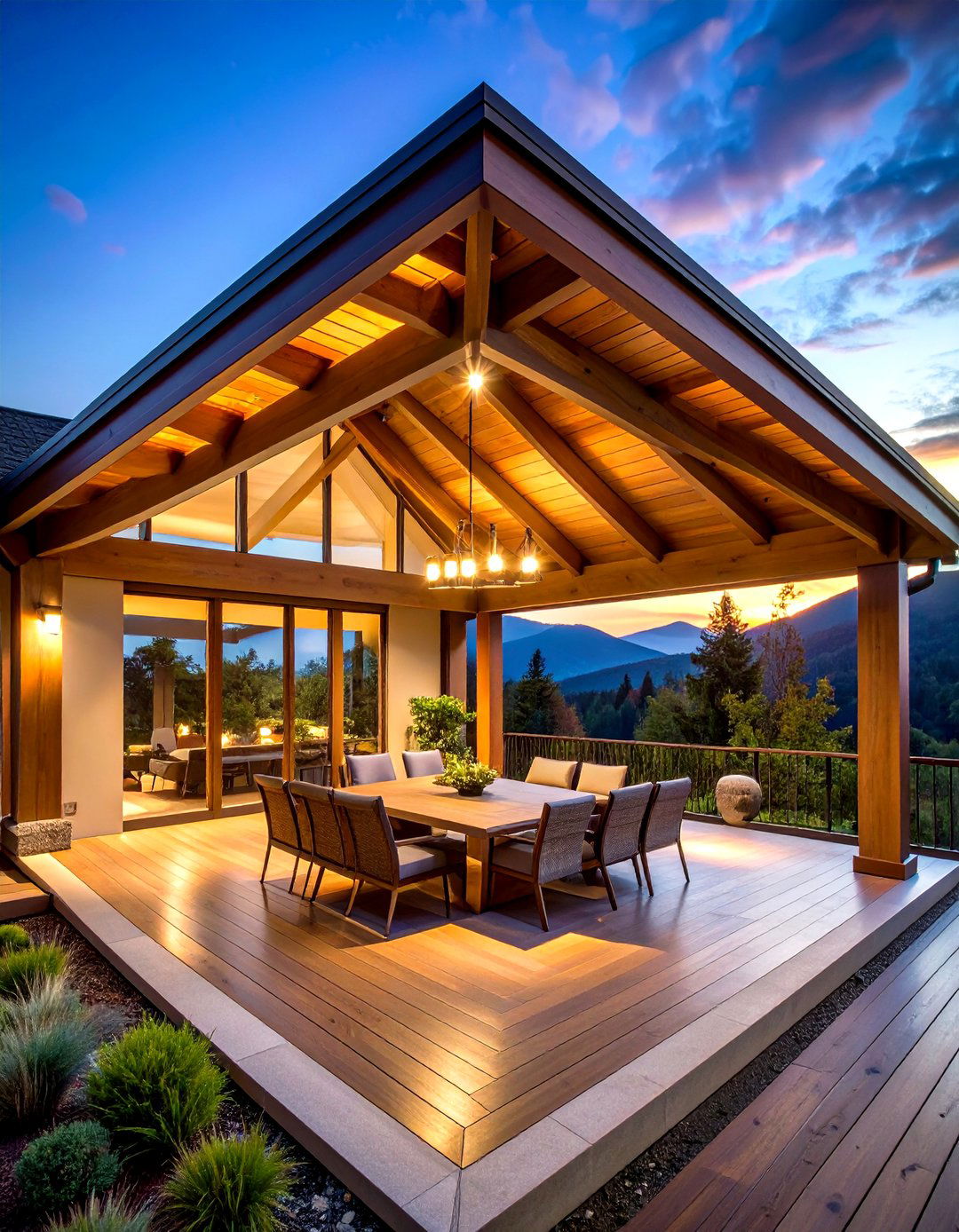
A steeply pitched gable patio roof lends an airy, cathedral-like feel without complex engineering, thanks to the inherent strength of two equal rafters meeting at the ridge. Its slope sheds rain and snow rapidly, reducing long-term maintenance and leak risk. Builders also appreciate the straightforward framing, which keeps construction time and cost in check. Visually, the generous angle draws the eye upward, creating room for statement lighting or ceiling fans. For homeowners in wetter climates, pair the pitch with deep overhangs to protect furniture and door thresholds, ensuring that this timeless silhouette performs as beautifully as it looks.
2. Raised Gable Patio Roof Elevates Both Ceiling and Mood

Opting for a raised gable patio roof—where the ridge sits higher than adjoining rooflines—instantly boosts head-room and daylight. The uplifted ridge captures breezes, cooling gatherings naturally, while accentuating views toward surrounding treetops or distant hills. Because support posts remain at standard height, you avoid the cost of extra-long columns yet still gain dramatic vertical space perfect for hanging pendants or a statement chandelier. Consider painting the gable infill a lighter hue than the rafters to exaggerate height further and create an inviting, loft-like outdoor retreat that never feels cramped.
3. Insulated Gable Patio Roof Panels Deliver Year-Round Comfort
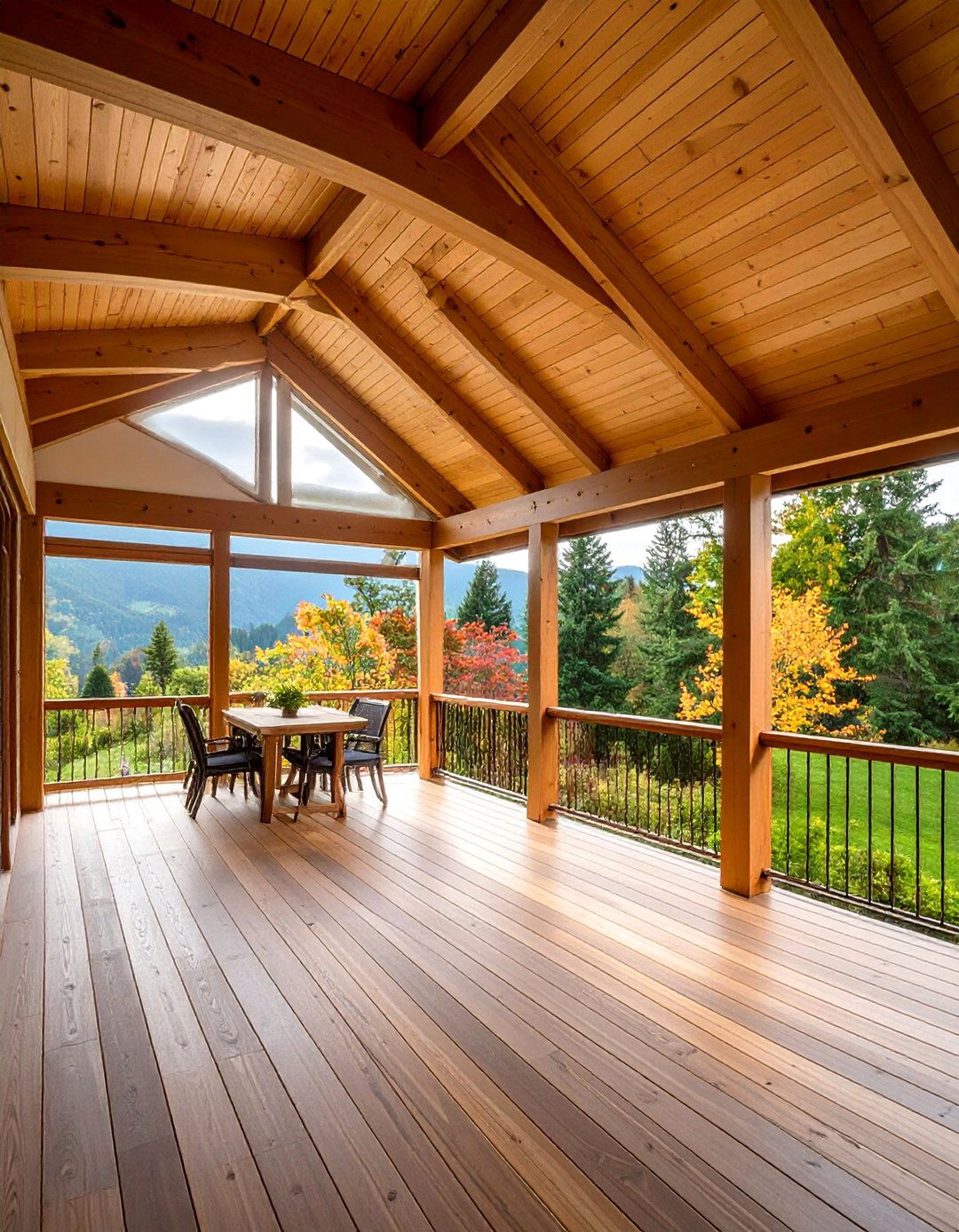
Insulated sandwich panels slot neatly between gable rafters, locking in warmth during winter and blocking radiant heat in summer. Many panels include concealed drainage channels, so the ceiling appears smooth and modern while moisture is harmlessly directed away. Better thermal performance means you’ll rely less on portable heaters or misters, trimming energy bills over time. In humid zones, the insulation also guards against condensation drip, preserving outdoor furniture fabrics. Finish the underside with v-groove boards for a polished look that hides seams—and enjoy a patio that earns its keep twelve months of the year.
4. Polycarbonate-Clad Gable Patio Roof Brightens Shaded Yards
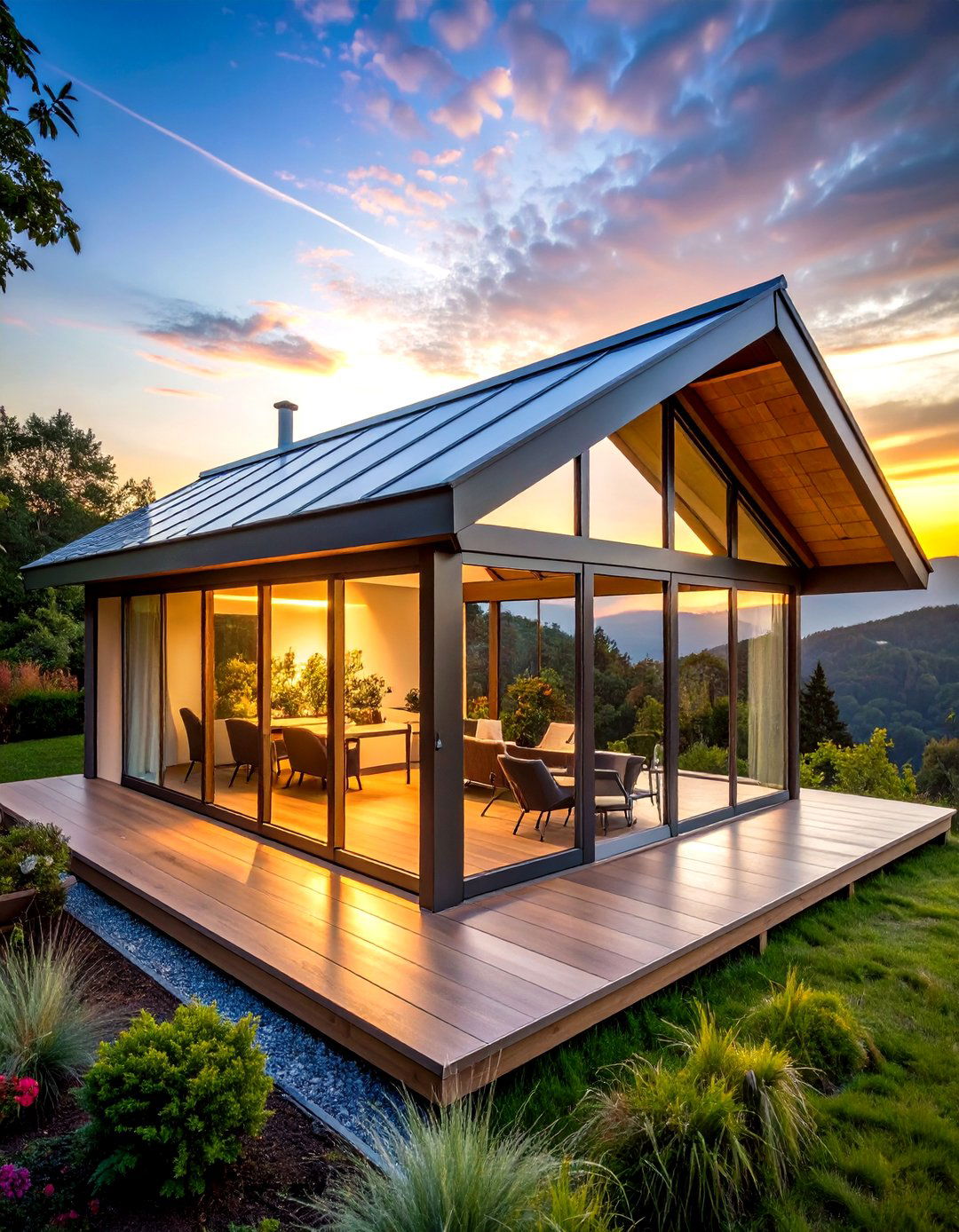
When yard orientation limits natural light, a polycarbonate gable patio roof rescues gloomy corners by letting 80-90 percent of daylight filter through while blocking harmful UV. New multi-wall sheets weigh a fraction of glass yet resist impact and discoloration, and many come in opal or bronze tints that soften glare. If midday heat is a concern, choose infrared-reflective glazing that diffuses sunlight but keeps temperatures down. Polycarbonate’s flexibility also permits gentle curving at the eaves, adding a contemporary flourish that rigid metal can’t match. Clean with mild soap twice a year, and the canopy keeps shining.
5. Metal-Clad Gable Patio Roof Handles Harsh Weather with Ease
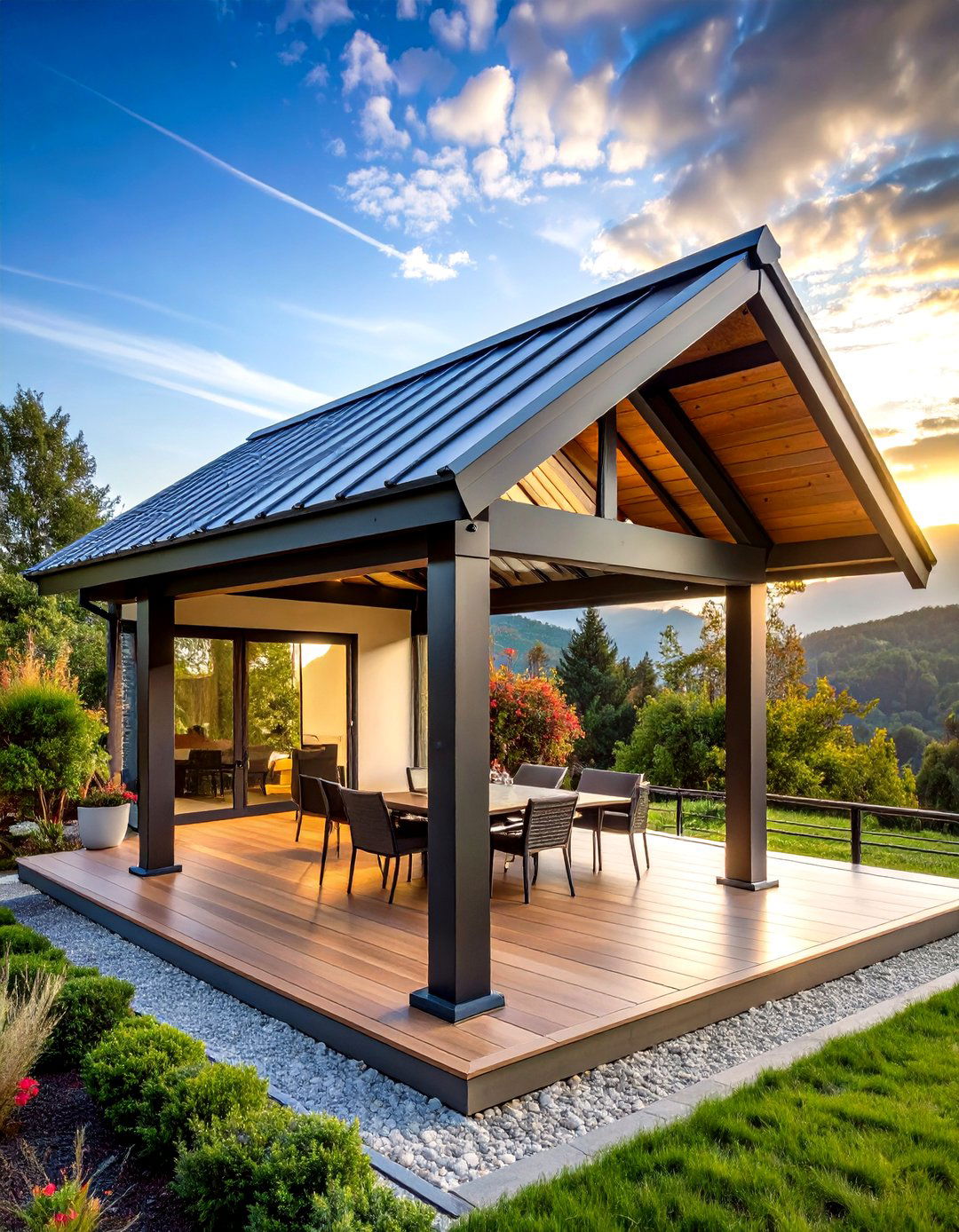
For homeowners in snow zones or coastal climates, a galvanized-steel gable patio roof offers unmatched resilience against rust, wind uplift, and heavy loads. Modern powder-coat finishes shrug off UV fading, extending the fresh-from-the-factory look far longer than bare corrugated sheets. The crisp metal profile pairs beautifully with industrial or minimalist landscapes, and its acoustic “ping” during light rain can be softened with a thin under-deck of plywood or acoustic mat. Combine the finish with slender black steel posts for a sleek pavilion that feels as solid as it looks.
6. Exposed-Beam Timber Gable Patio Roof Celebrates Craftsmanship
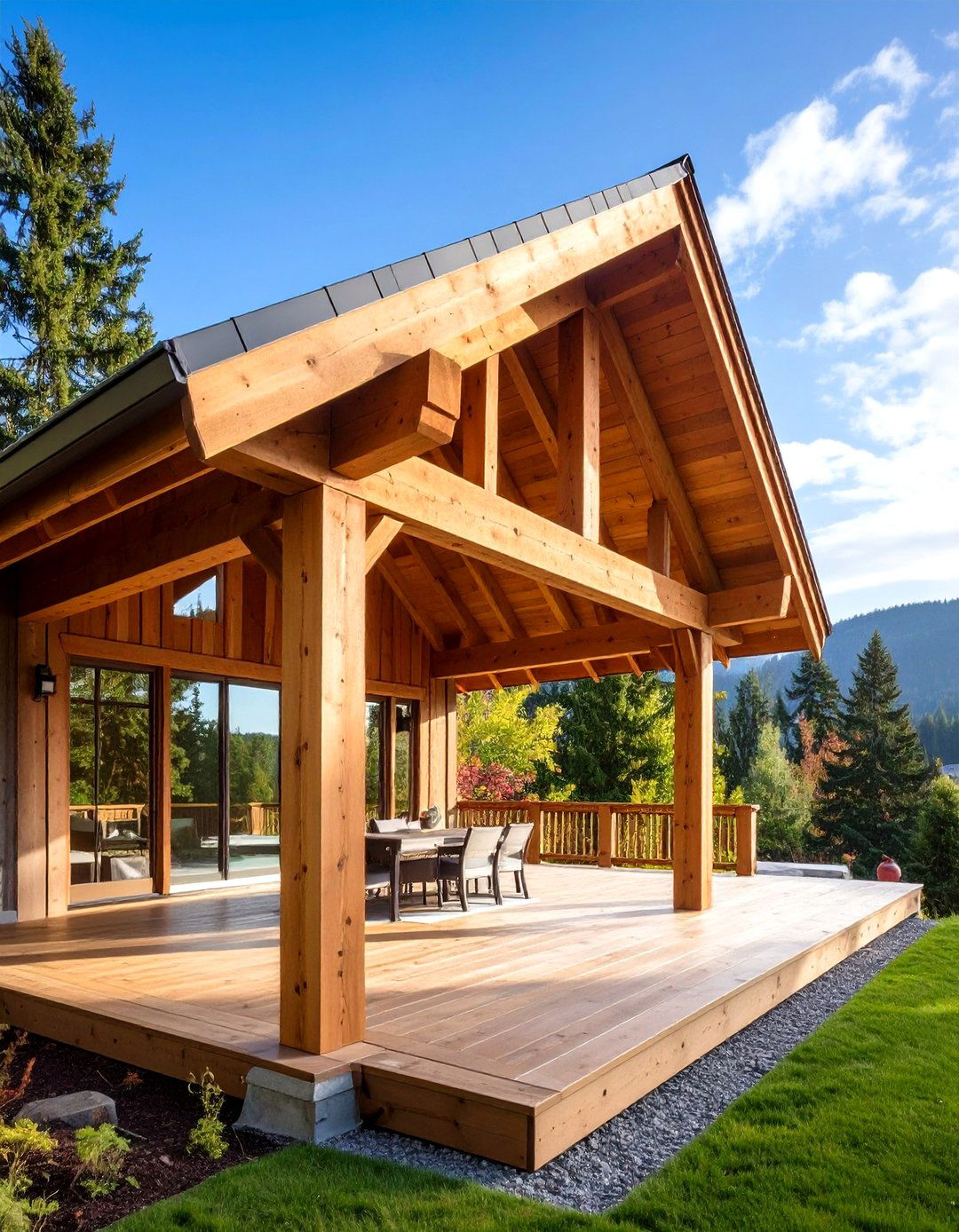
A timber-framed gable patio roof with exposed rafters showcases natural grain and joinery, delivering a warm, lodge-inspired ambiance. Contemporary timber-frame systems use oversized glulam or Douglas-fir beams that span wider distances, trimming the need for interior posts and opening sightlines. Stain the wood a rich walnut to contrast pale decking, or lime-wash for coastal flair; either way, recessed downlights can nest between rafters without visible wiring. Regular sealing defends against UV and moisture, but the payoff is an outdoor room that feels handcrafted and enduring—ideal for mountain cabins and suburban decks alike.
7. Skylight-Ready Gable Patio Roof Keeps Air and Light Moving
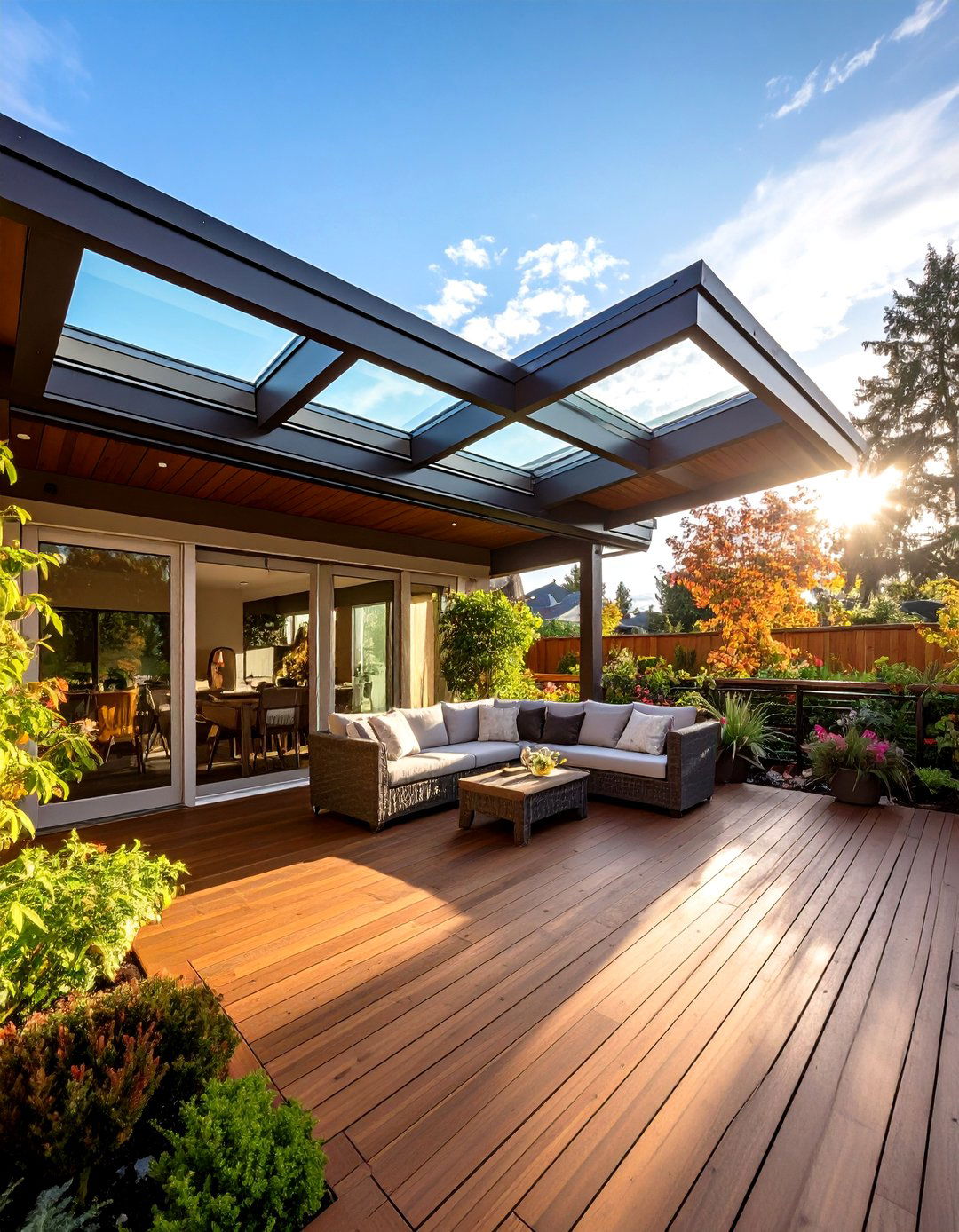
Installing vented skylights high on a gable patio roof draws stale air out while ushering fresh breezes in, reducing reliance on mechanical fans. Position skylights on the leeward slope to accelerate passive venting, and choose models with low-E glazing to control heat gain. The added daylight brightens evening meals, cutting energy use for lighting. Pair each unit with an integrated insect screen so summer nights remain buzz-free. With careful flashing, skylights blend seamlessly into the roof plane, offering unobstructed sky views even when rain drives you under cover.
8. Solar-Ready Gable Patio Roof Turns Shelter into Power Plant
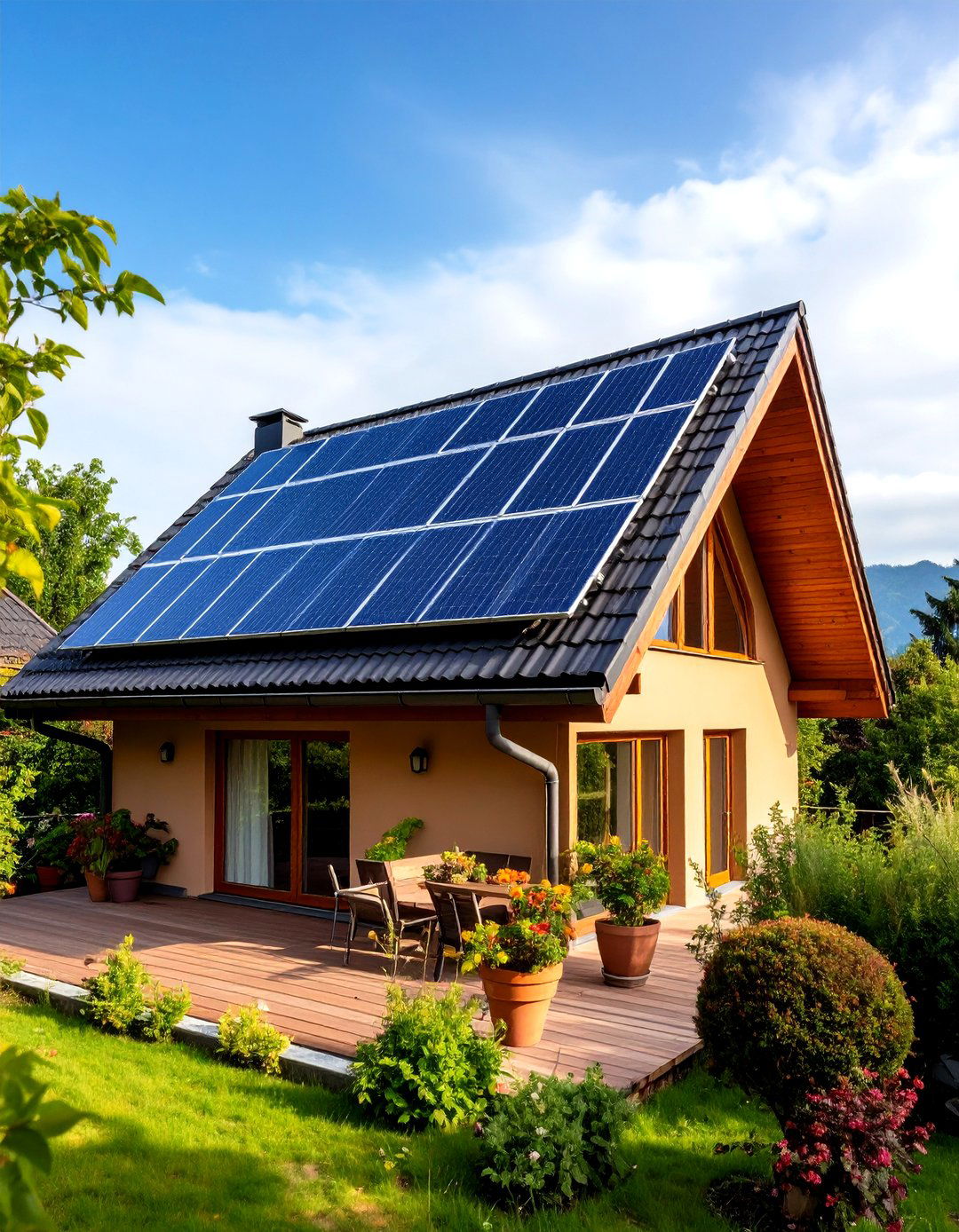
Because a gable patio roof offers two broad, angled planes, it is prime real estate for photovoltaic panels—especially the south-facing slope. Mounting rails fasten directly to rafters, keeping weight evenly distributed and preserving waterproofing. Running conduit inside the ridge beam conceals wiring for a cleaner ceiling below. Even a modest 2-kW array can offset string-light and outdoor-kitchen loads, edging the patio toward net-zero operation. If future expansion is likely, specify trusses engineered for additional panel weight and orient the ridge true east-west to maximise daily sun capture.
9. Living-Green Gable Patio Roof Softens Hardscapes Naturally
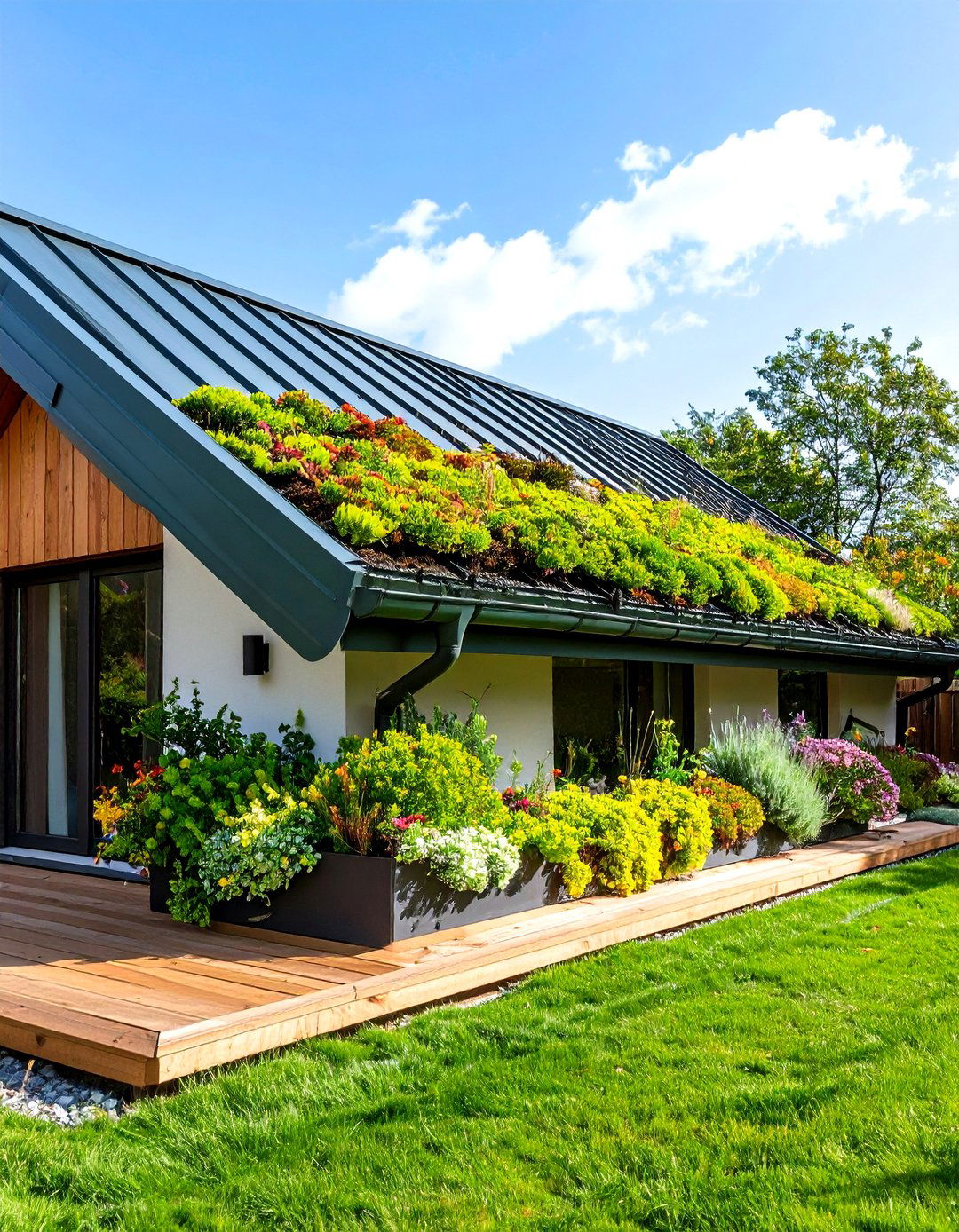
A low-pitch gable patio roof can host an extensive green-roof blanket of sedum and hardy grasses, cooling the micro-climate and filtering rainwater before it hits gutters. Lightweight trays lock into purlins, spreading load safely, while root-barrier membranes protect decking below. Besides curbing urban heat-island effect, the living layer dampens sound and insulates, keeping temperatures stable beneath. Drip irrigation set on a timer maintains vegetation with minimal attention. The result is a canopy that blends into surrounding foliage, turning an ordinary patio cover into an ecological statement piece.
10. Acoustic-Lined Gable Patio Roof Tames Rain-Storm Rattle
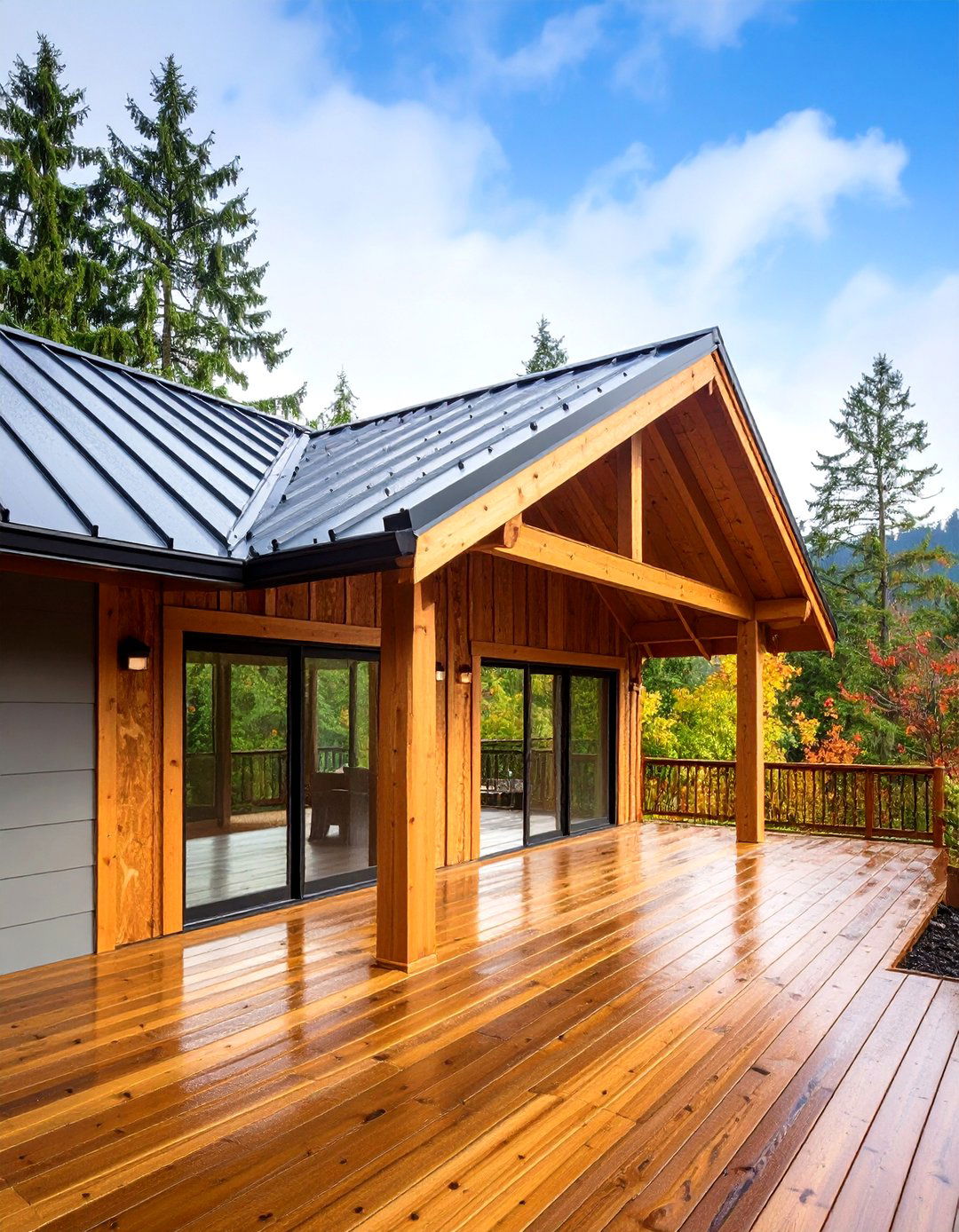
If pounding rain on metal cladding ruins conversation, add acoustic insulation boards or spray-on cellulose beneath the gable patio roof skin. Homeowners report that even a thin, high-density layer noticeably reduces drum-like resonance and hail noise. For a finished look, overclad the insulation with cedar T&G boards or fiber-cement soffit panels. Bonus: the added mass improves thermal resistance, making shoulder-season gatherings more comfortable. Choose moisture-resistant products rated for exterior use, and vent the ridge so sound-absorbing materials stay dry and effective over time.
11. Powder-Coated Aluminum Gable Patio Roof Frame Resists Corrosion
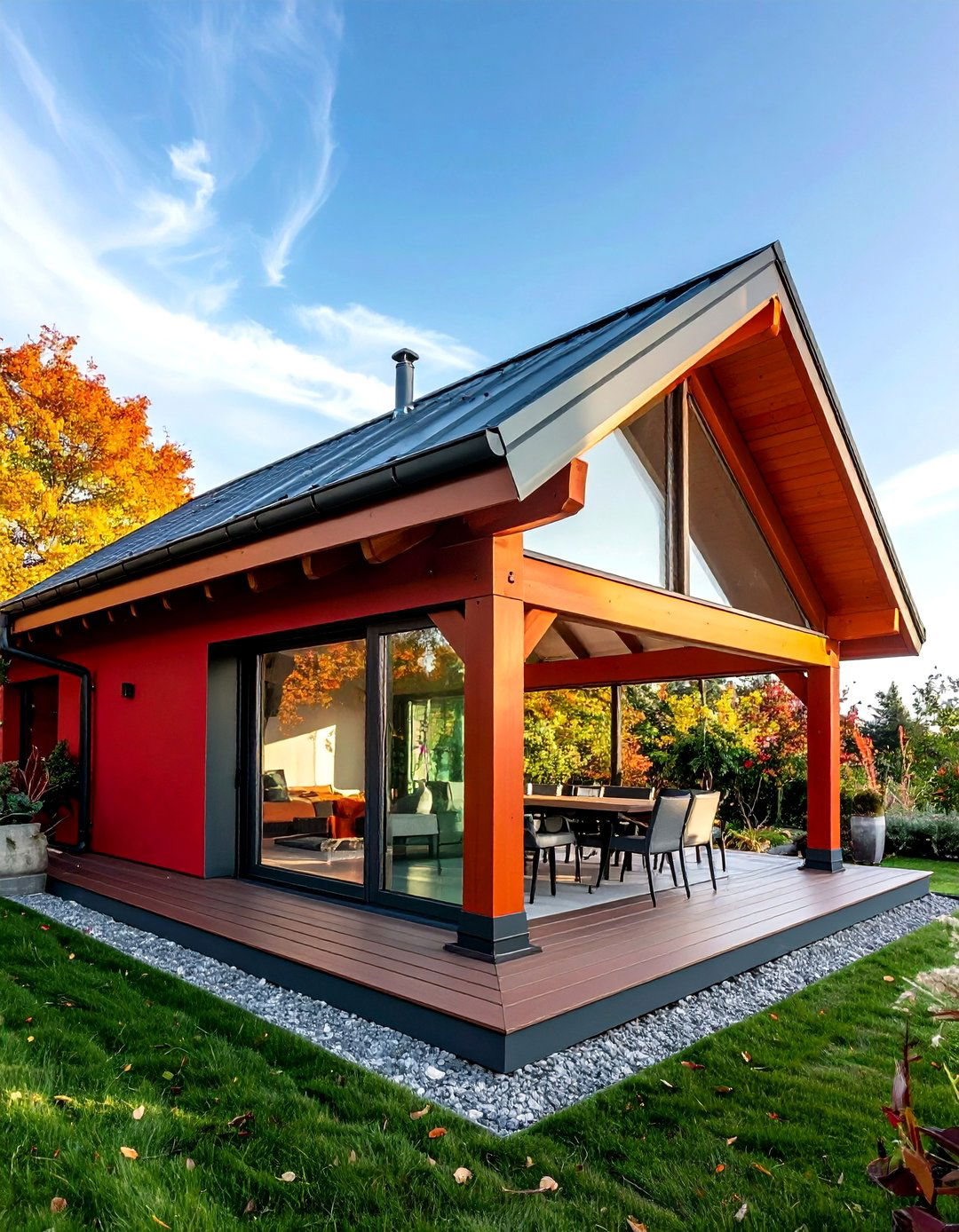
Salt-spray zones demand materials that won’t pit or peel, making a powder-coated aluminum gable patio roof frame a smart long-term investment. The baked-on finish forms a tough skin that shrugs off scratches and chalking, while aluminum’s low weight eases footings and speeds installation. Pair the frame with matching fascia trim for a unified modern aesthetic, or contrast black posts with a pale roof deck for graphic impact. Occasional washing with mild detergent restores factory sheen, keeping maintenance duties light enough to fit between weekend barbecues.
12. Hybrid Timber-and-Steel Gable Patio Roof Balances Warmth and Strength
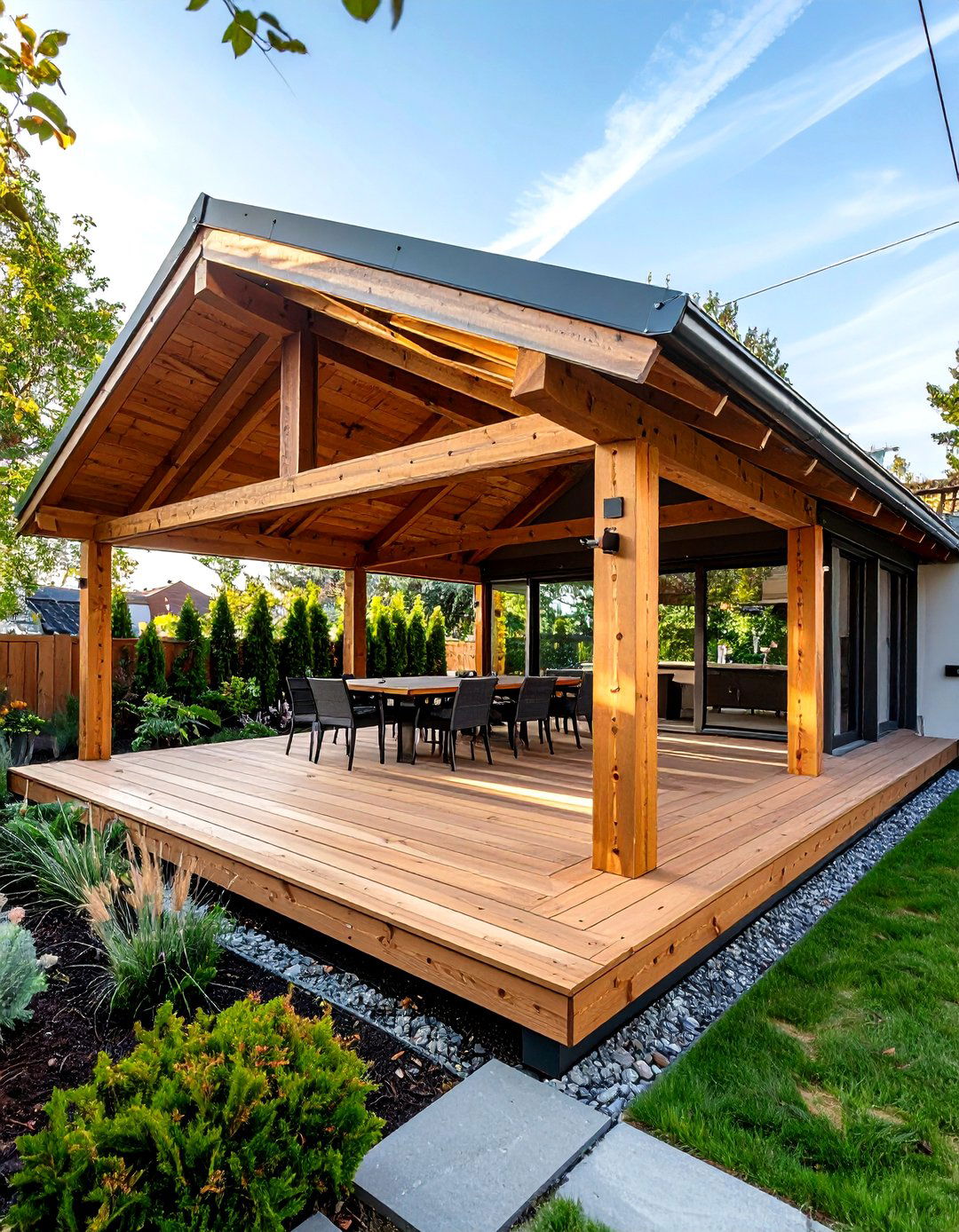
Combining timber posts with a powder-coated steel or aluminum gable patio roof harnesses the best of both worlds: natural texture below and weatherproof durability above. Wood-grain sublimated steel panels mimic cedar without upkeep, resisting termites, fire, and UV fading. Steel’s spanning power minimizes rafters, so the ceiling reads clean and uncluttered, while timber posts ground the structure visually in the landscape. Seal posts with an exterior oil to harmonize tones and prevent splitting, and consider steel knee braces for a subtle industrial nod that stiffens the frame against high winds.
13. LED-Lit Gable Patio Roof Extends Evening Enjoyment
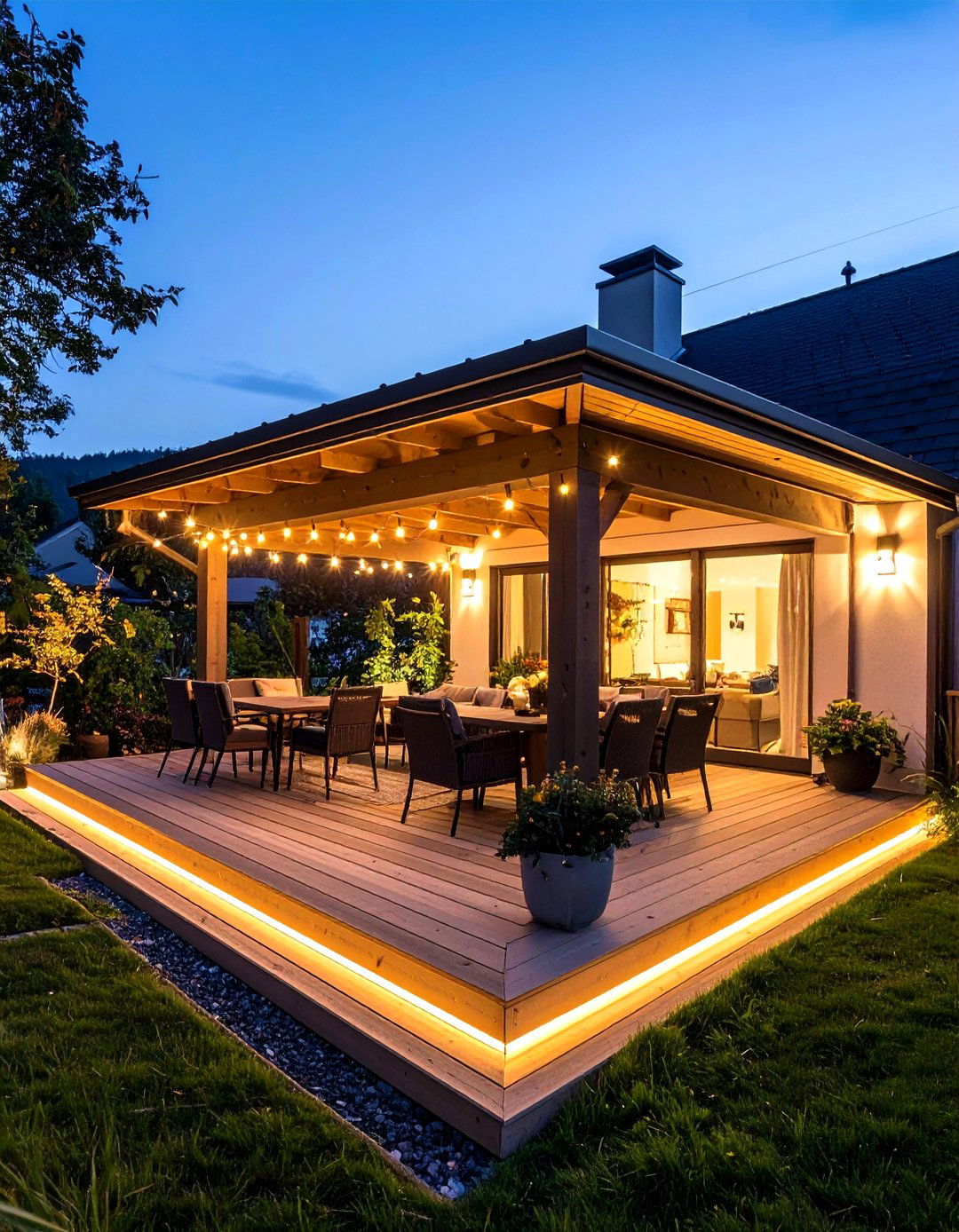
Thoughtful lighting transforms a gable patio roof from daytime shelter to nighttime lounge. Recessed LED downlights fitted between rafters offer glare-free task lighting for dining, while low-voltage strip LEDs tucked along the ridge beam add soft uplight that accents the roof’s geometry. Choose fixtures rated for damp locations and link them to a smart dimmer for scene control. Highlight posts with tiny ground-spot uplights to frame the perimeter. This multi-layered approach not only enhances safety but sets an inviting ambience worthy of long alfresco dinners.
14. Cathedral-Style Double Gable Patio Roof Creates Grand Scale
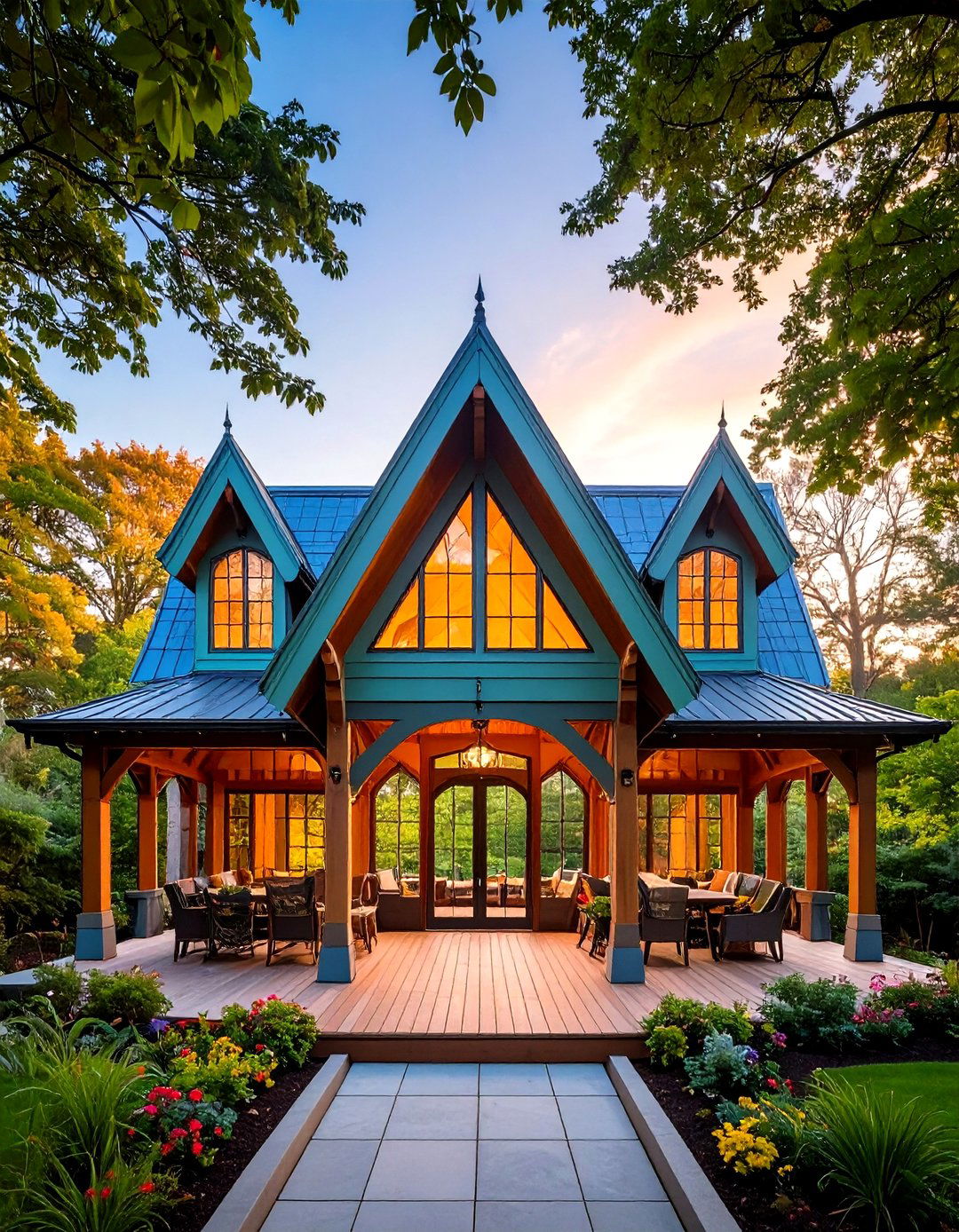
A double-gable or cathedral configuration pairs two steep pitches that meet high at center, delivering soaring volume reminiscent of resort pavilions. Such designs top the 2025 trend lists for homeowners wanting dramatic silhouettes and extra wall height for transom glazing. The elevated ridge allows clerestory windows that flood interiors with daylight while maintaining weather protection. Structural ridge beams transfer loads cleanly to posts, keeping the floorplan wide open. Finish underside rafters in crisp white to reflect light and amplify the sense of spaciousness.
15. Screen-Enclosed Gable Patio Roof Turns Bug Season into Bonus Time
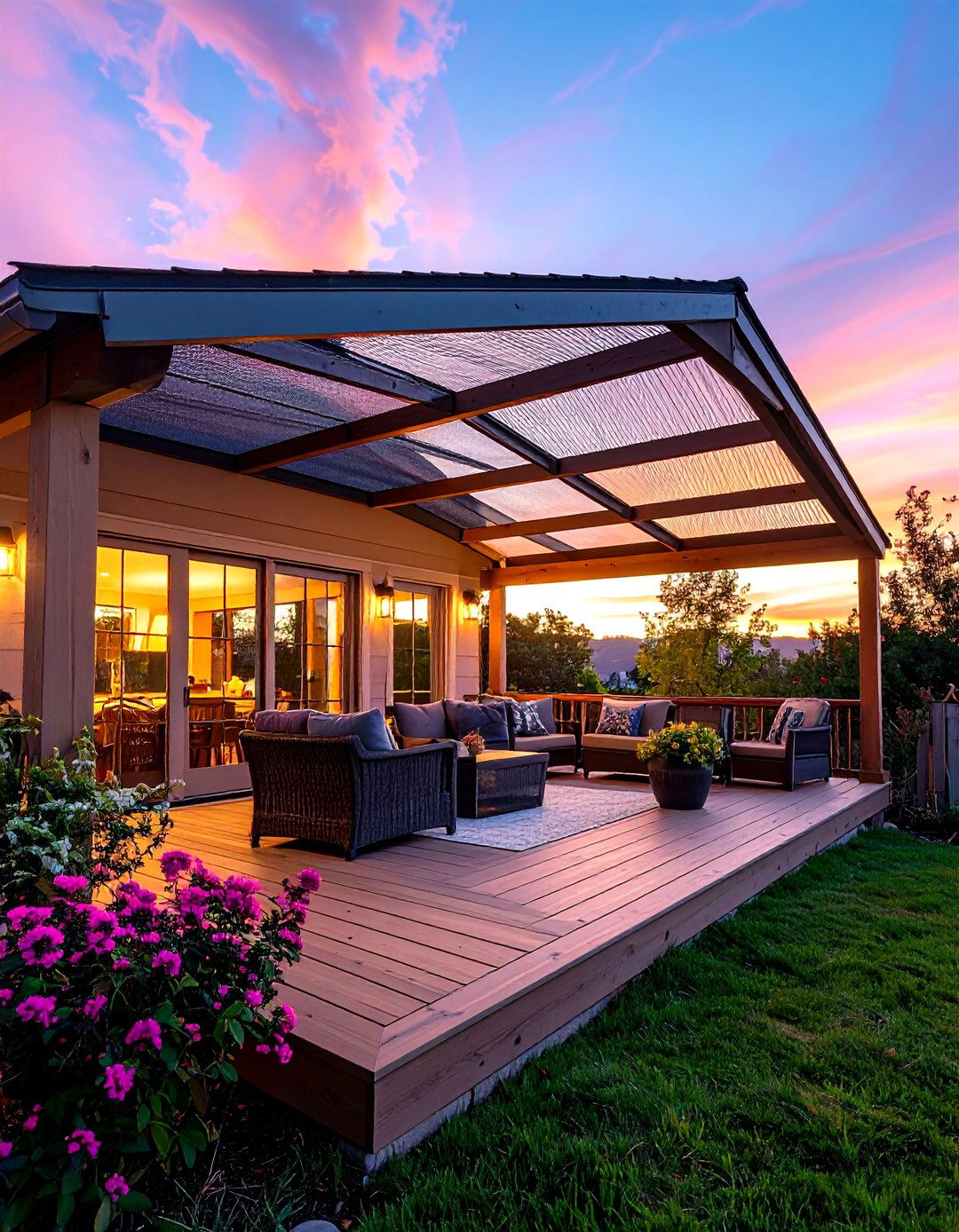
Wrapping the perimeter in fine mesh converts a gable patio roof into an airy screened room, shielding dinner guests from mosquitos without sacrificing sky views. Popular lanai-style enclosures adapt easily to gabled frames, integrating sliding glass panels for four-season use in milder climates. Because screens add negligible weight, existing footings often suffice, and ceiling-mounted fans keep airflow fresh. Choose dark bronze mesh to reduce glare and make panels visually “disappear,” so you still feel immersed in the garden after dusk.
16. Louvered Gable Ends Encourage Continuous Cross-Ventilation
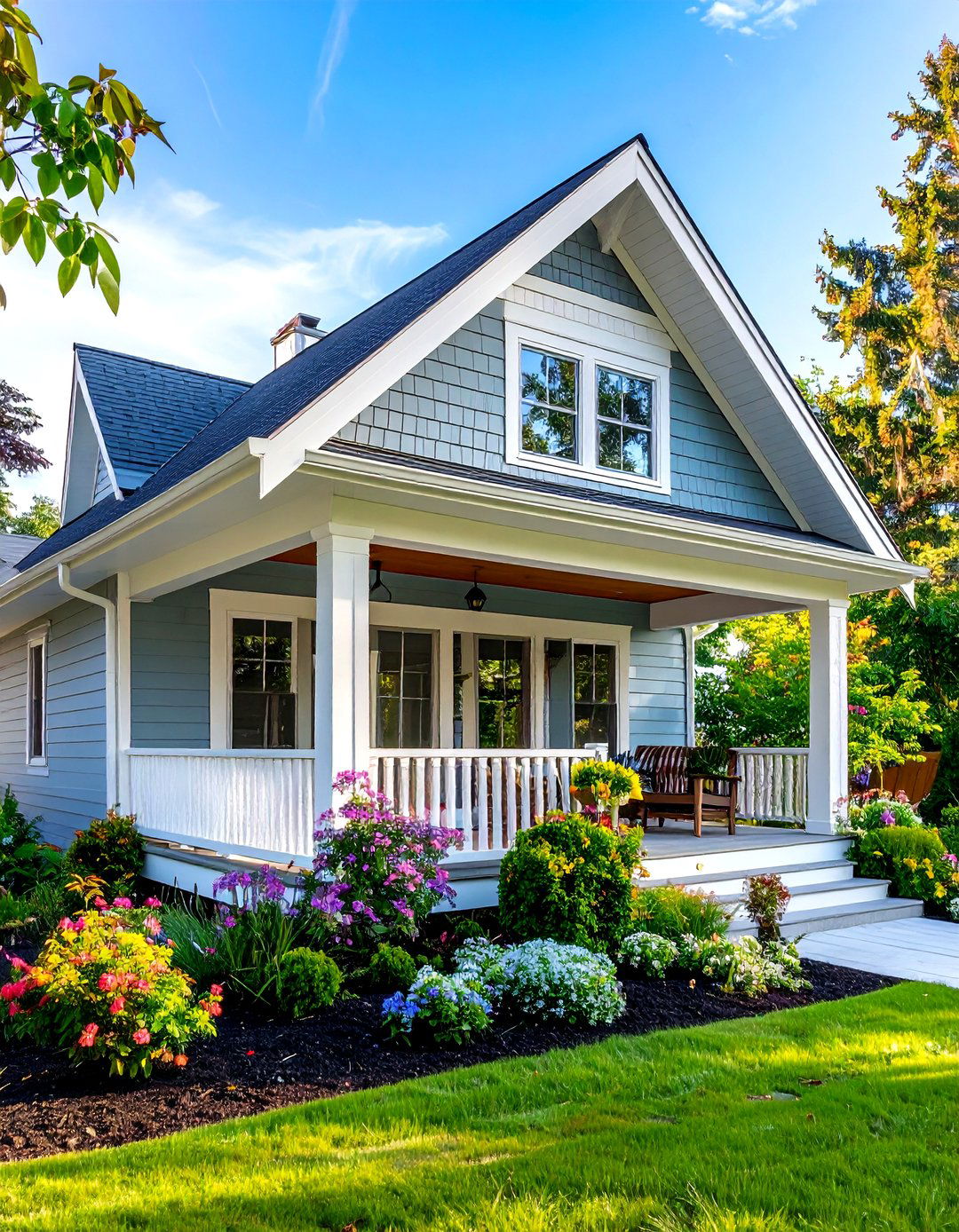
Installing adjustable louvers in the triangular gable ends lets you fine-tune airflow as weather changes. Gable vents already offer superior ridge-to-eave air movement; louvers make that performance controllable, shielding rain when needed and opening wide during summer heat spikes. Many kits mount flush to framing and match roof color for a seamless look. The extra ventilation lowers humidity under the roof deck, which prolongs paint life and deters mold growth on cushioned seating.
17. Stone-Pier Gable Patio Roof Grounds the Structure with Rustic Charm
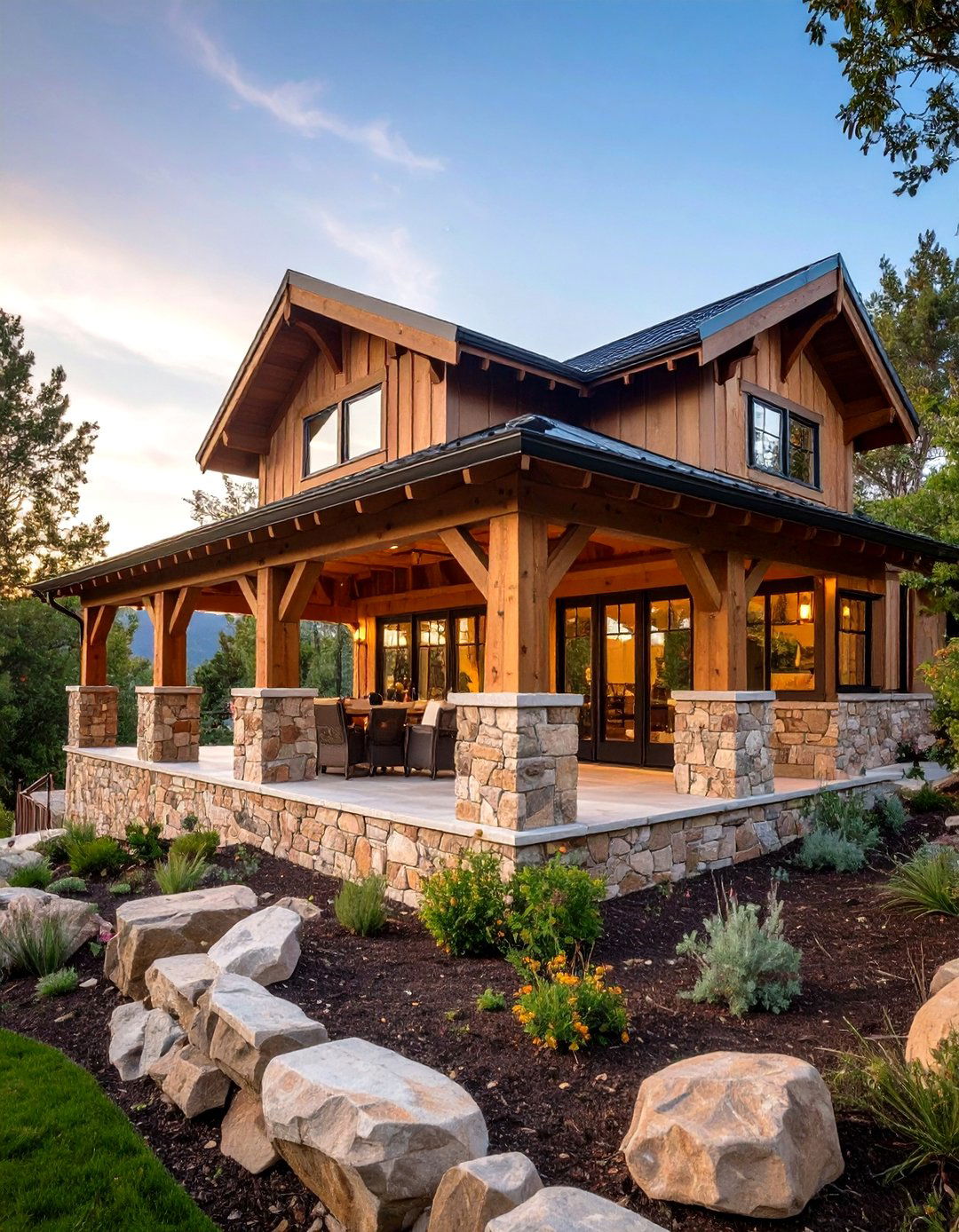
Swapping standard timber posts for stone or brick piers anchors a gable patio roof visually and structurally, echoing farmhouse porch traditions while resisting rot at ground level. Mixing materials—stone below, timber or steel above—creates textural depth that designers count on for curb appeal. Core-drill the pier tops to conceal steel post anchors, giving the illusion that beams simply rest on masonry. Finish joints with a tinted mortar that echoes roof color for cohesive styling.
18. Minimalist Studio-Inspired Gable Patio Roof Embraces Clean Lines
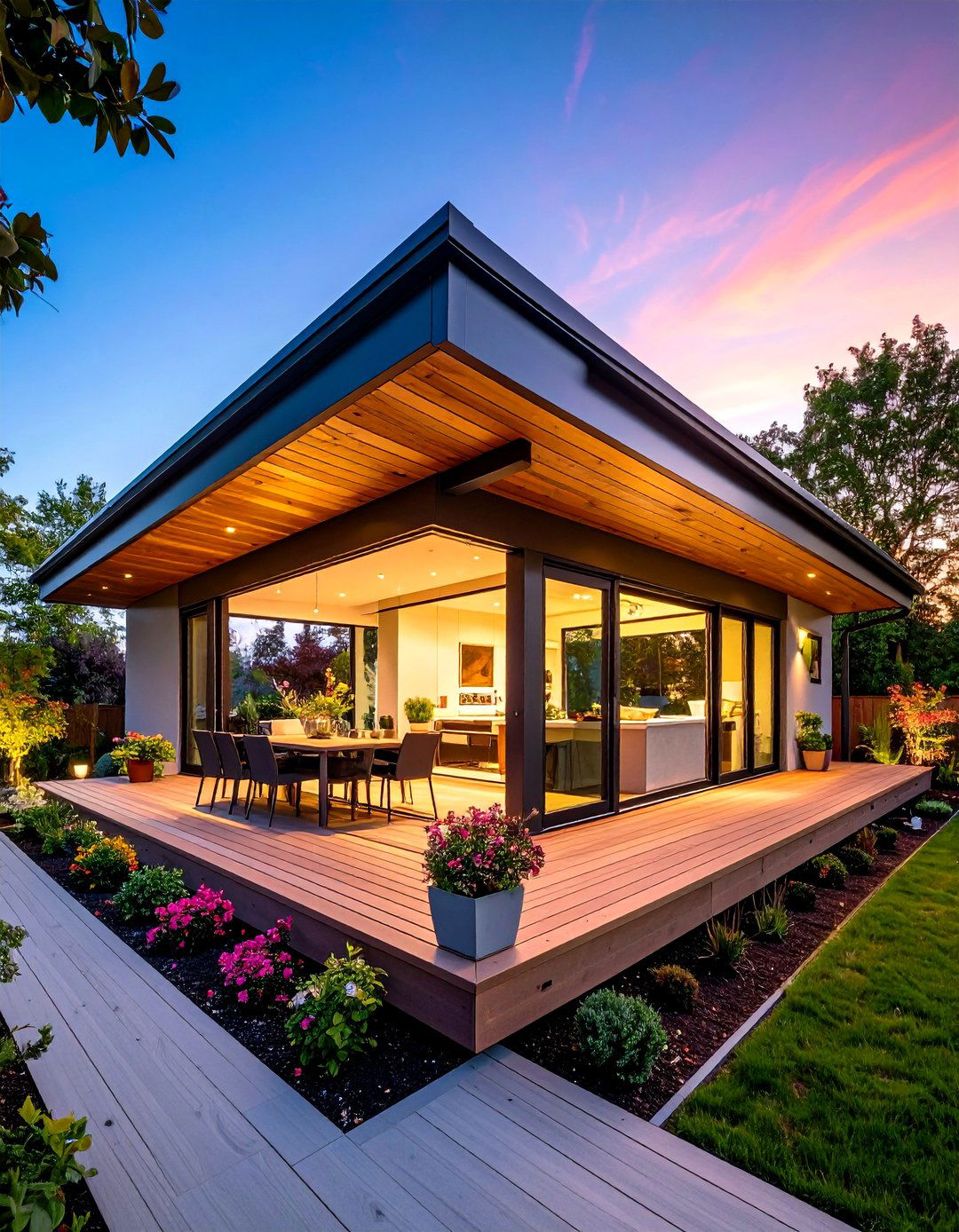
Although studio roofs are often single-slope, you can borrow their minimalist ethic by specifying a shallow-pitch gable patio roof with concealed gutters and slim fascia. Studio-style simplicity tops patio roof wish-lists for 2025, pairing especially well with mid-century or contemporary façades. Keep the ceiling flat and unadorned, and recess linear LED channels for a gallery-like glow. Because the geometry is understated, material quality takes center stage—think seam-free aluminum panels or smooth painted plywood for a crisp, modern finish.
19. Rain-Harvesting Gable Patio Roof Makes Sustainability Visible

A gable patio roof’s twin slopes naturally collect water toward fascia gutters that feed downpipes; directing that runoff into barrels or a subsurface tank supports garden irrigation and reduces storm-drain overload. Green-roof advocates note that harvesting can complement living-roof systems by reusing overflow in dry months. Fit leaf guards to keep debris out and add a first-flush diverter for cleaner storage. Painted steel chains can replace traditional downspouts, turning functional water flow into a decorative feature that delights during summer showers.
20. Modular Prefab Gable Patio Roof Kits Simplify DIY Builds
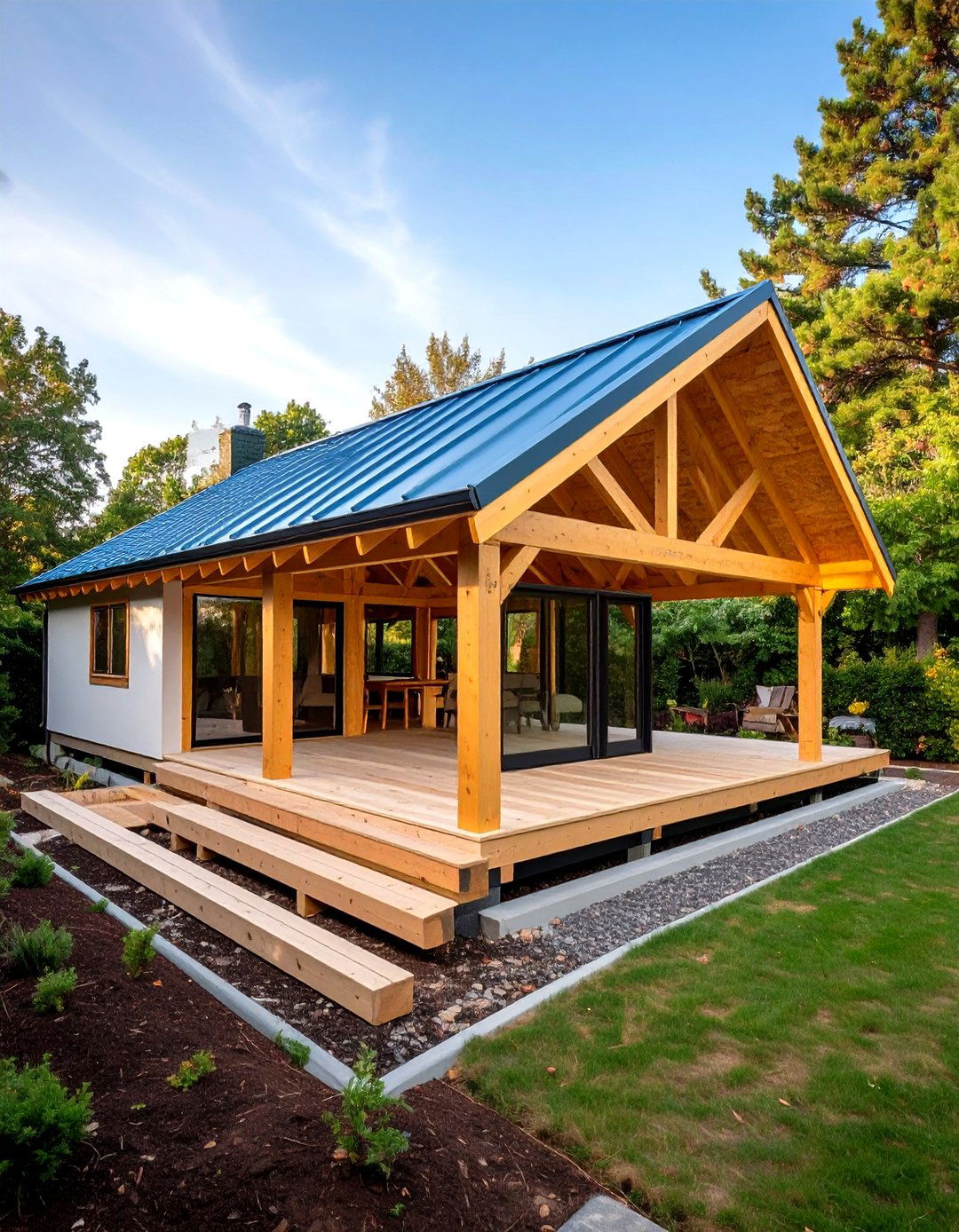
Home-center kits now ship with pre-cut, labeled parts—powder-coated aluminum frames, steel roof panels, and hardware—that two people can assemble over a weekend with basic tools. Clear instructions and factory-matched fasteners shorten build time and reduce errors, making a gable patio roof achievable even for first-time DIYers. Some models include optional curtains, screens, or snow-load upgrades, so you can tailor the kit to local climate. Before ordering, verify footing requirements and check municipal setback rules to keep the installation smooth from unboxing to first cookout.
Conclusion:
Whether you crave the airy drama of a cathedral ridge, the eco-benefits of a living roof, or the no-nonsense resilience of powder-coated steel, a gable patio roof adapts effortlessly to your goals while lending classic architectural grace. Each idea above shows how thoughtful tweaks—insulation, skylights, solar panels, or smart framing—transform a simple pitched shelter into a multi-season hub that saves energy, resists weather, and elevates outdoor life. Use these concepts as a checklist, mix and match features that resonate, and let your new gable patio roof frame countless memories under open skies.


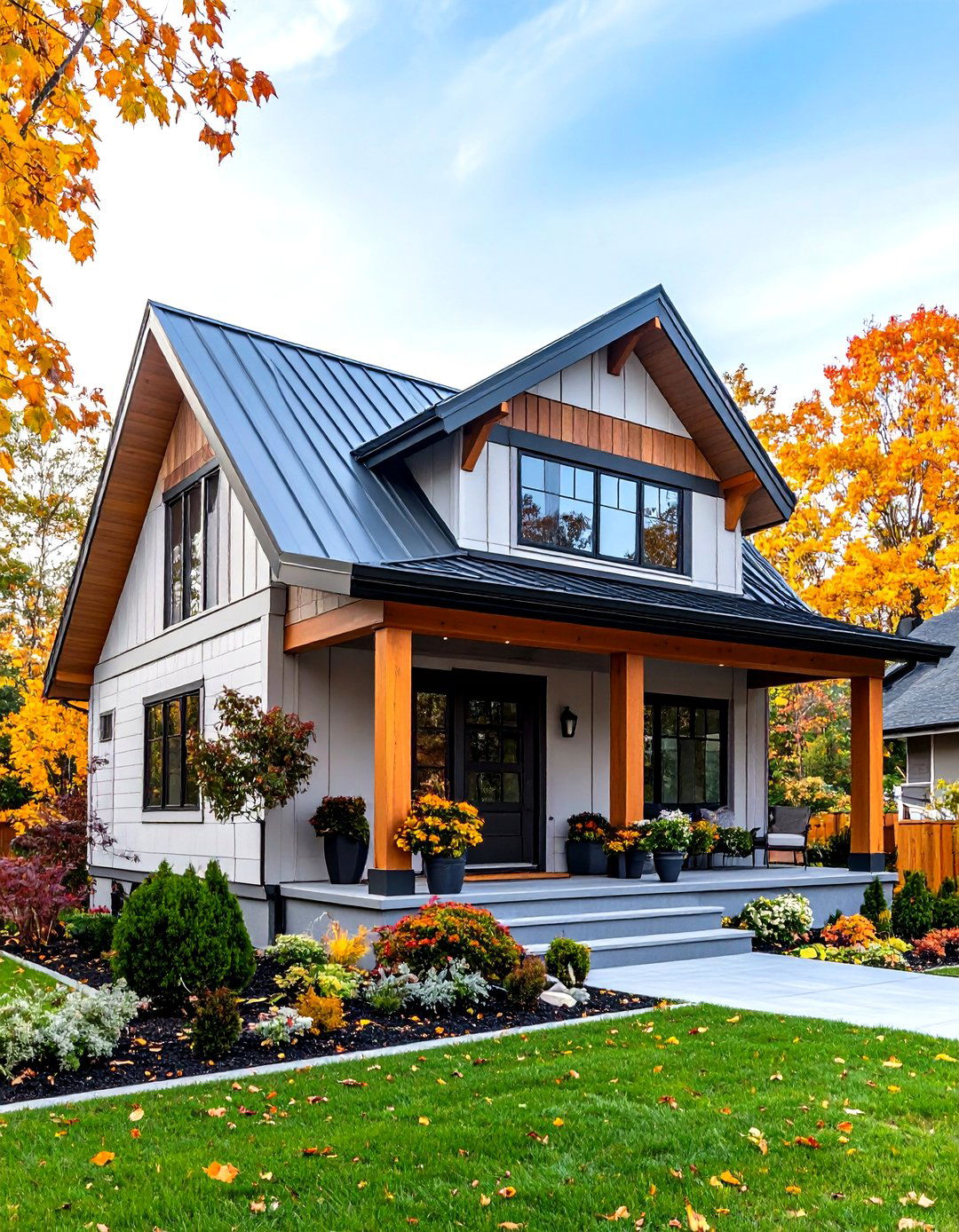
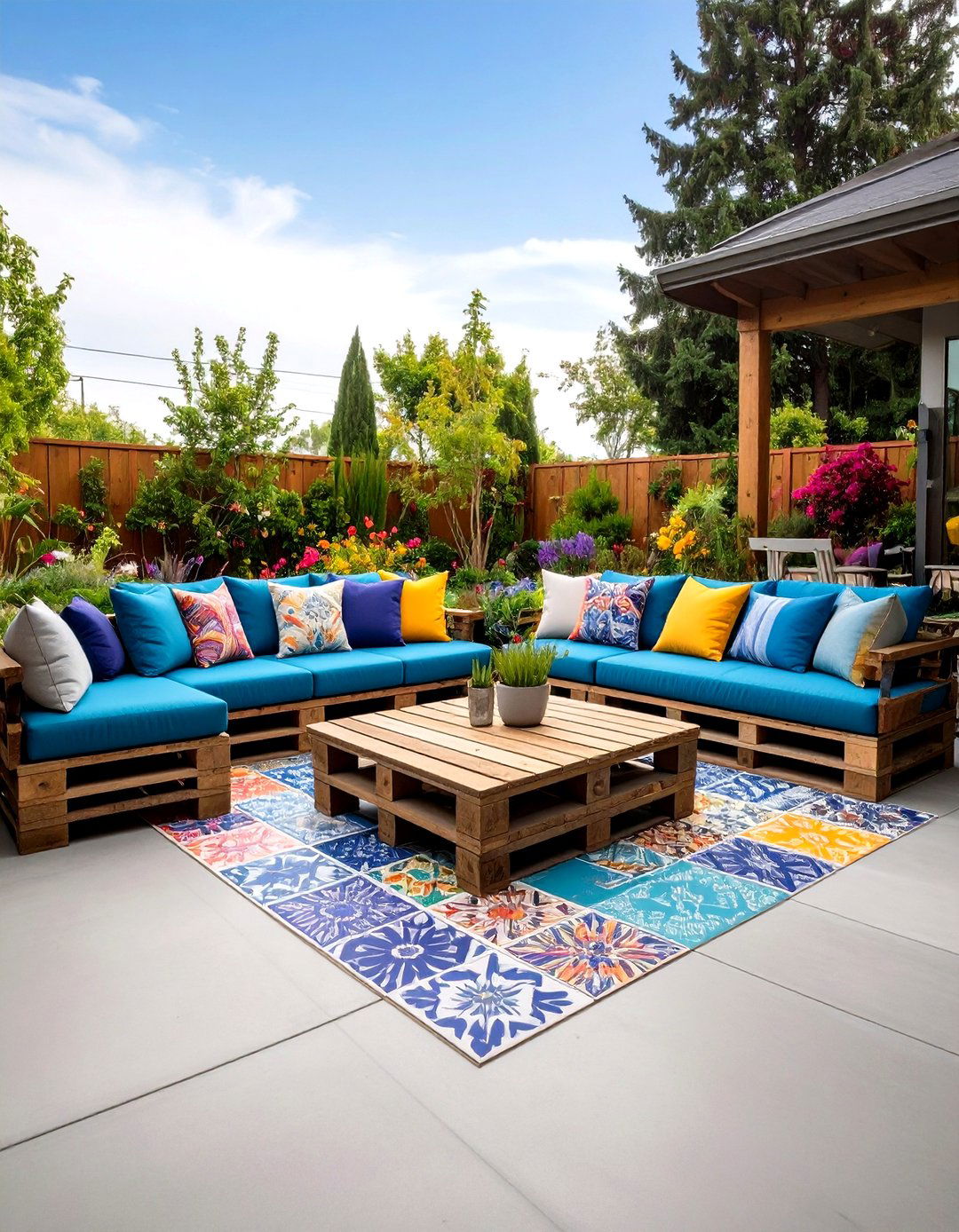
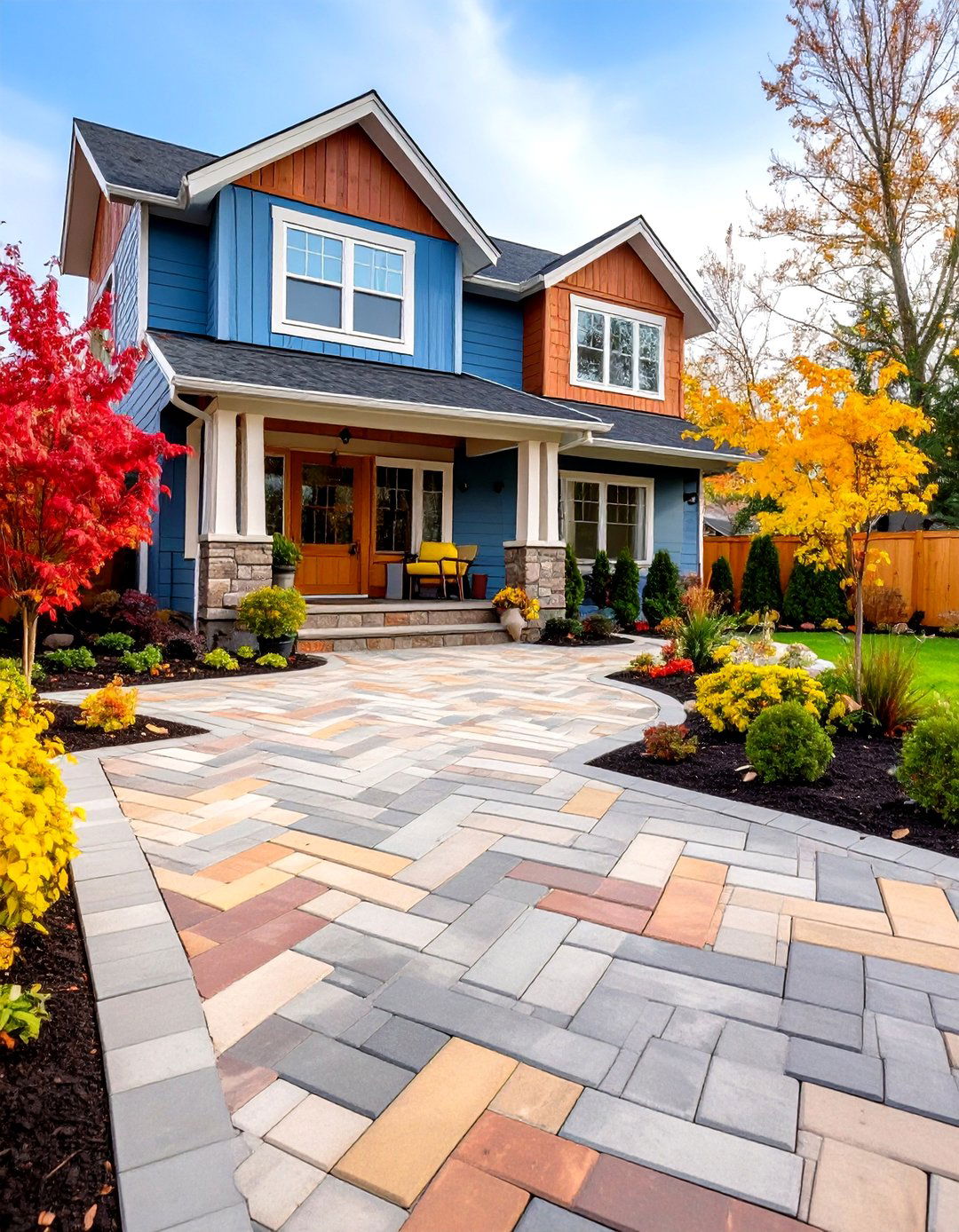

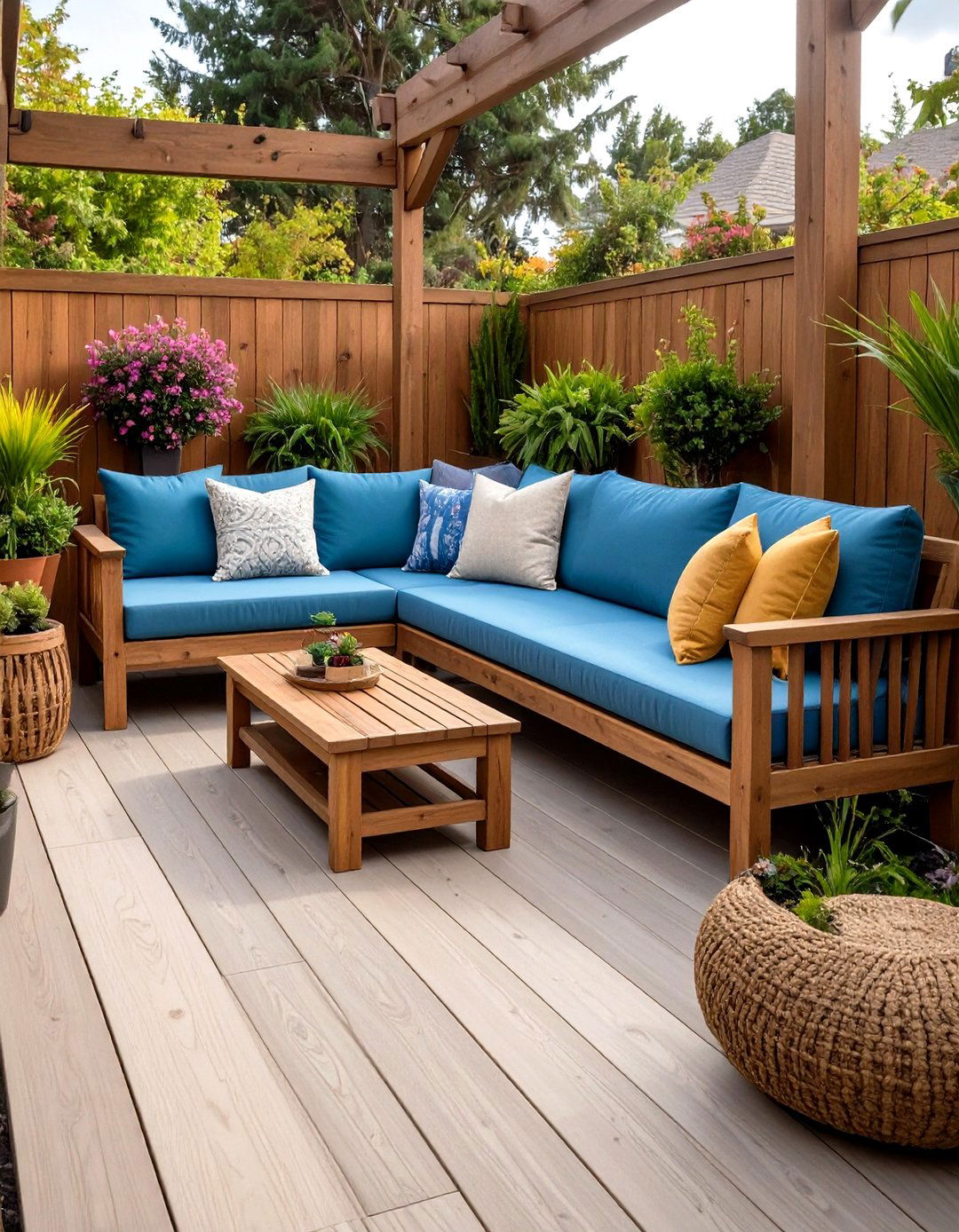
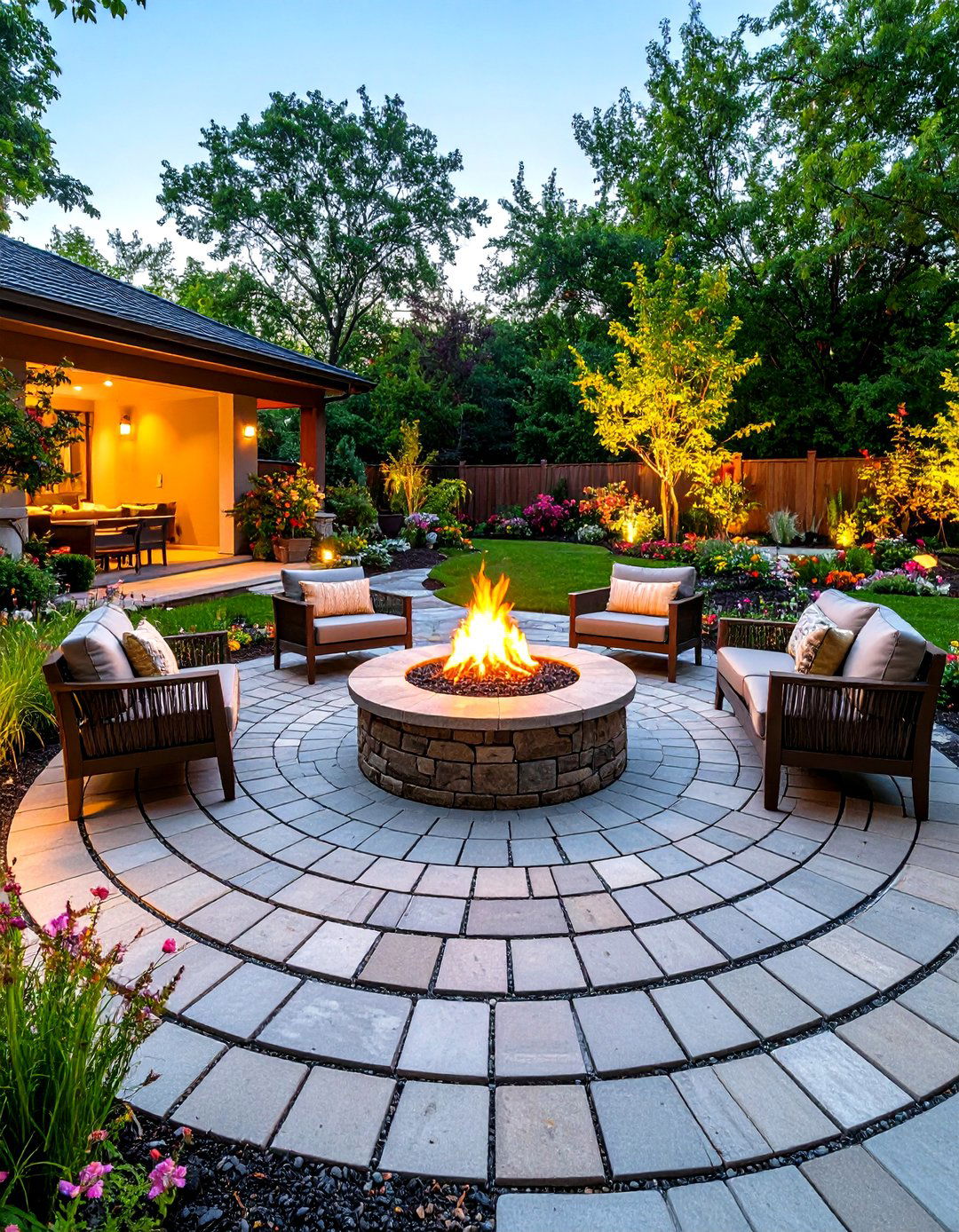
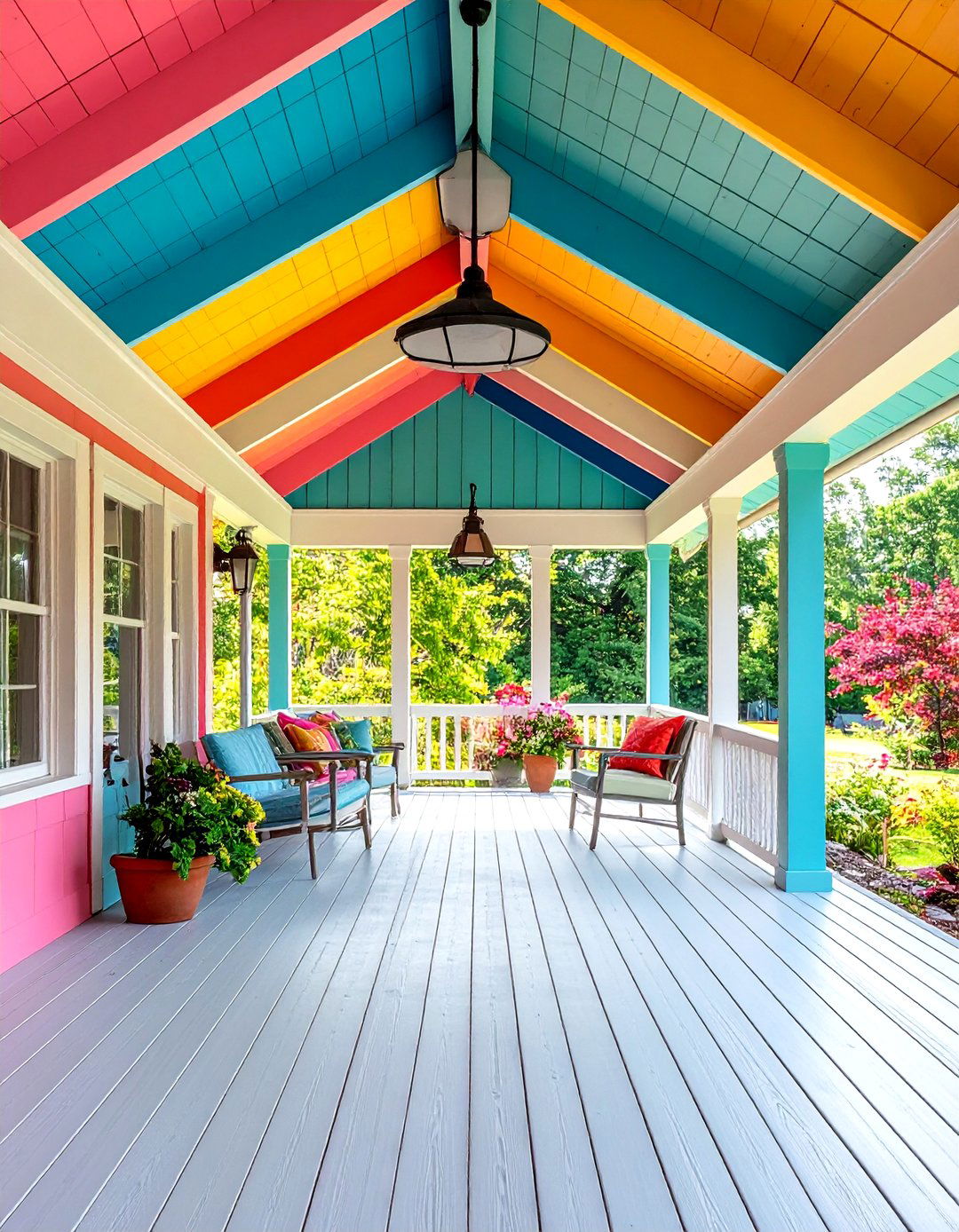
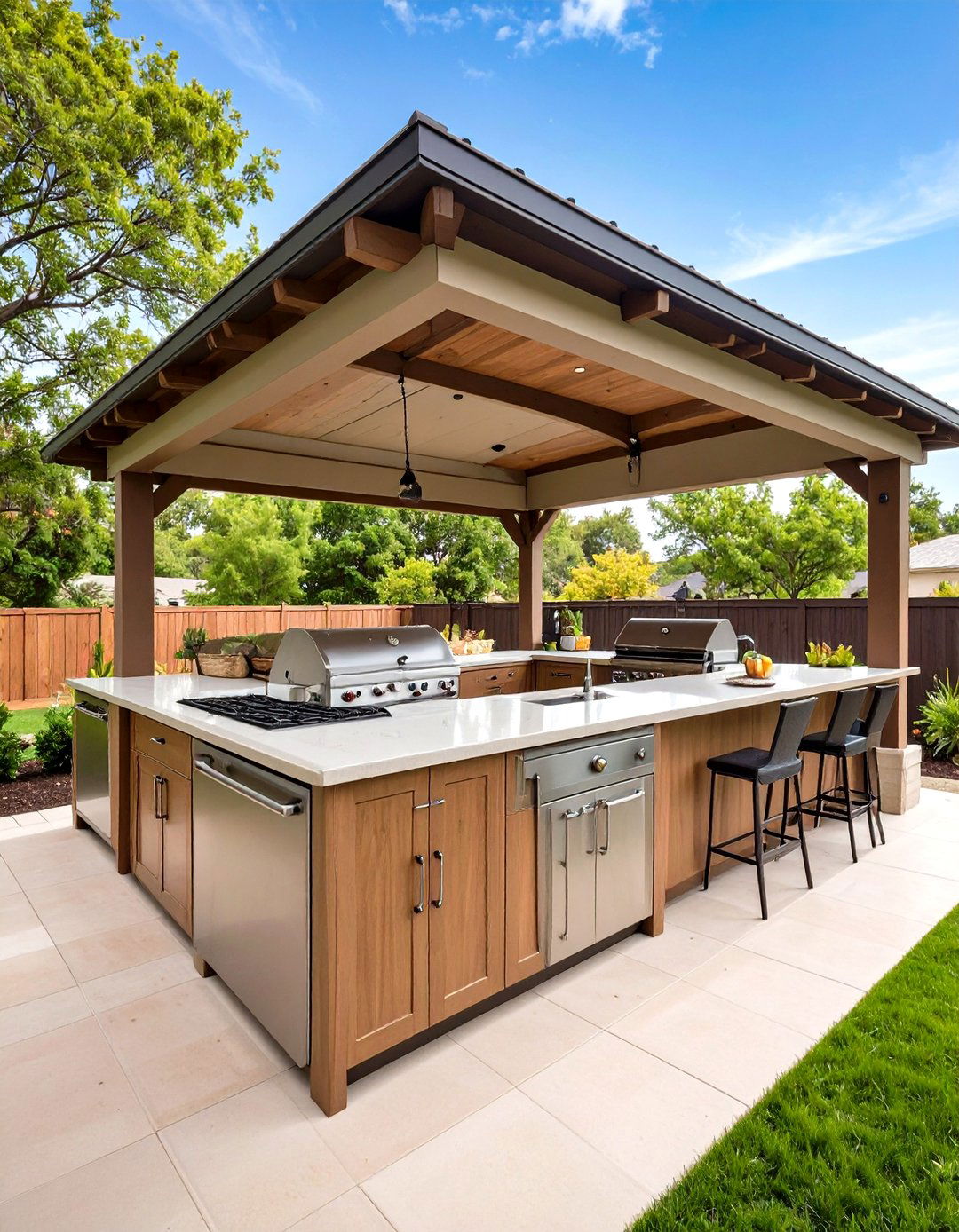
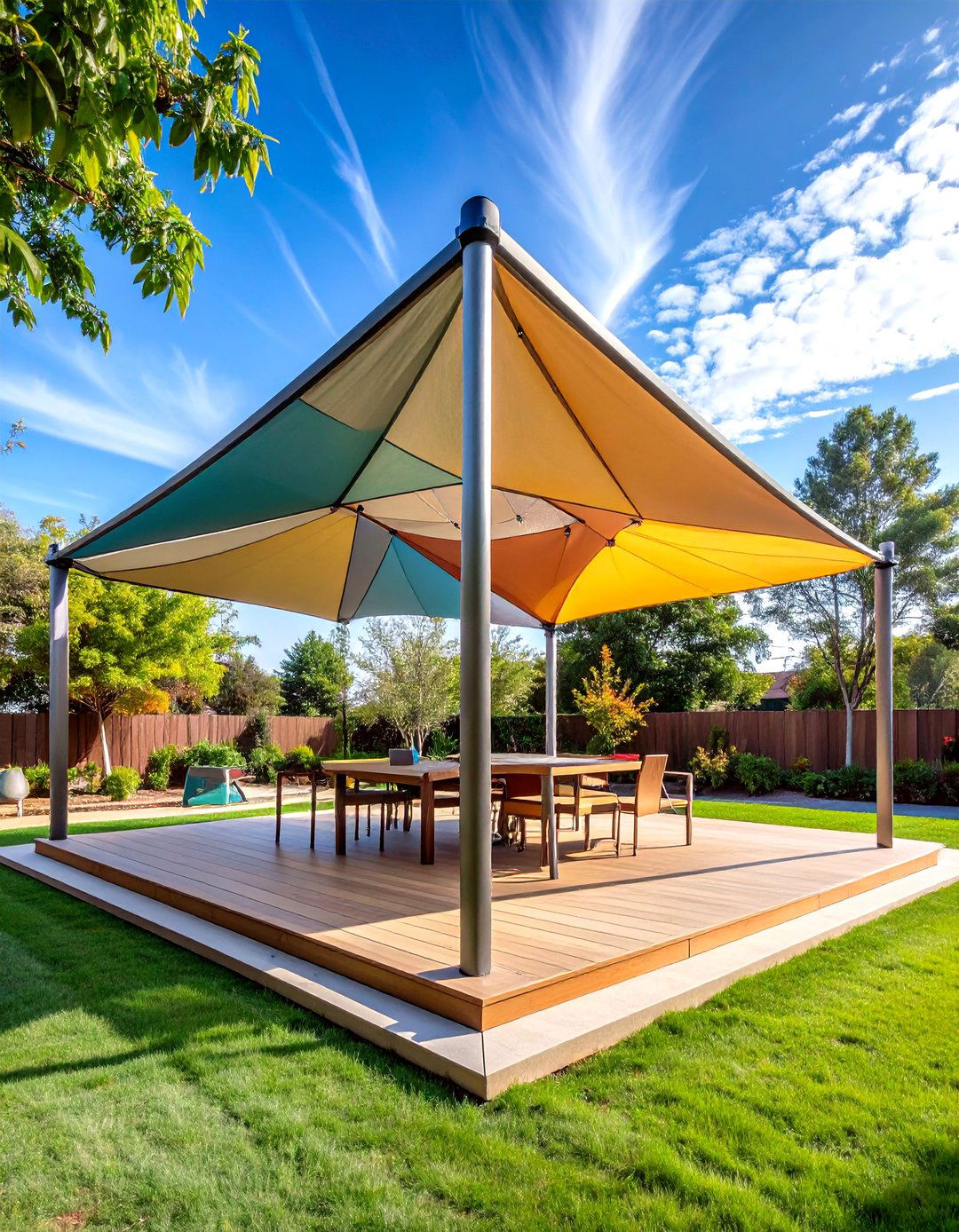
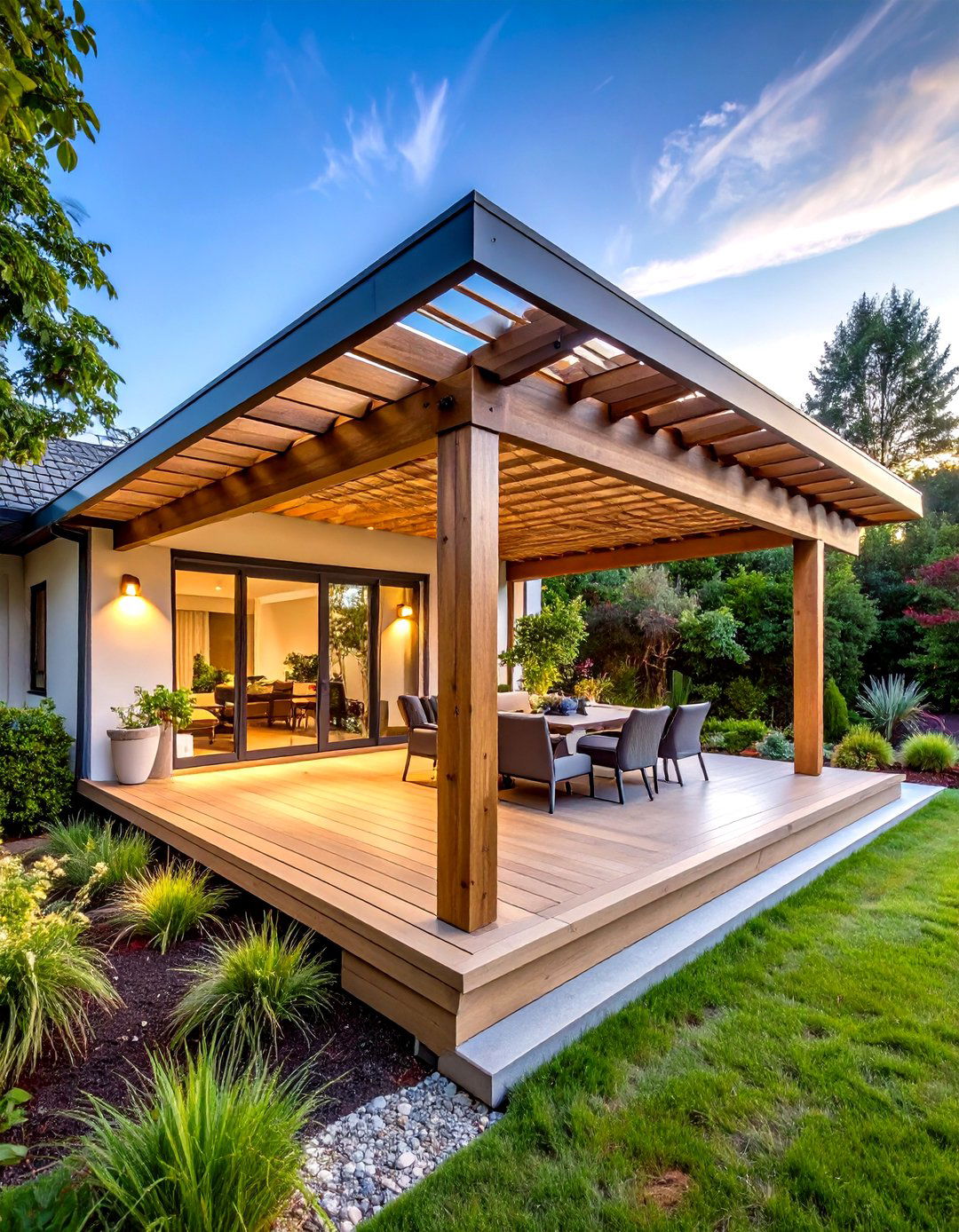
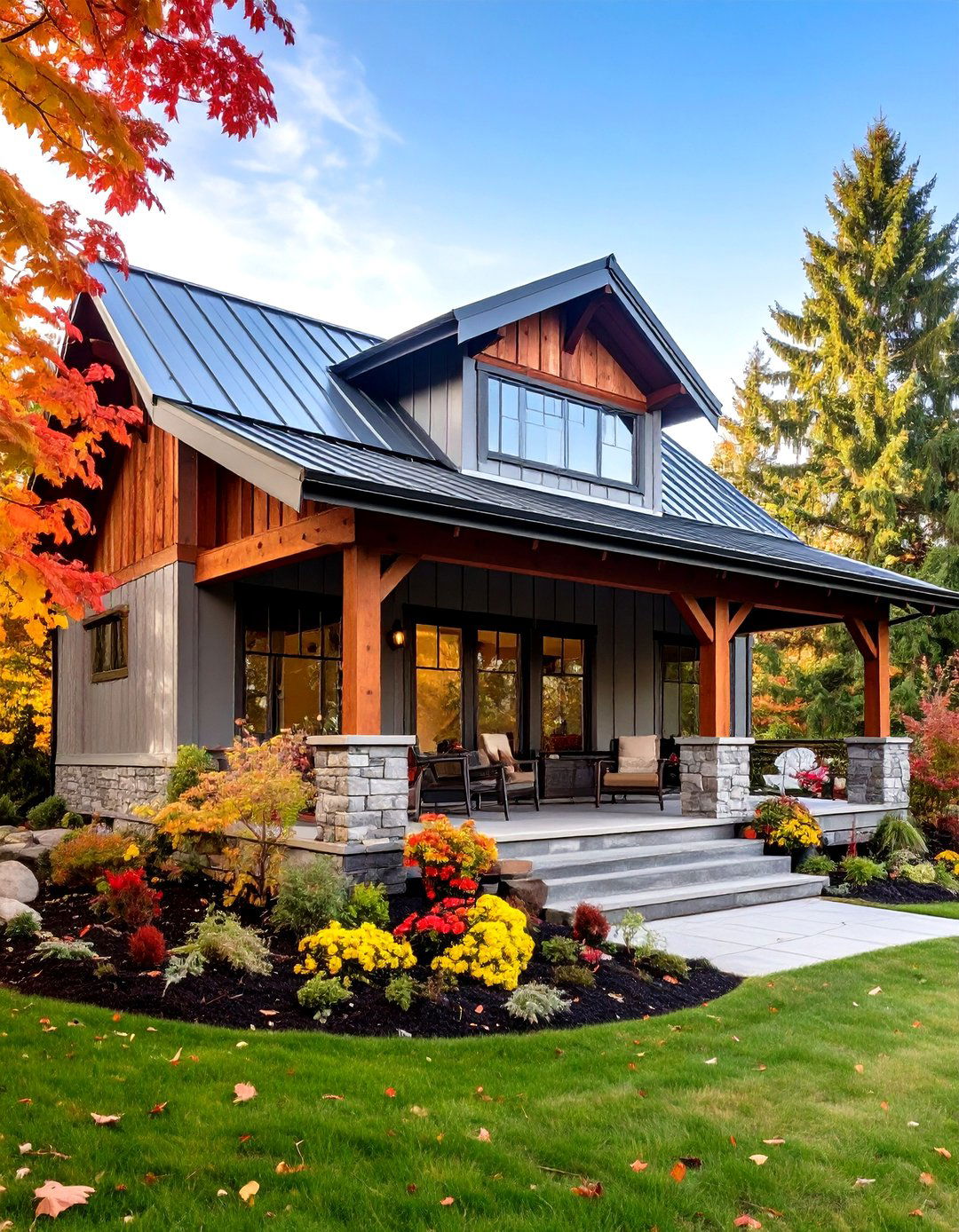
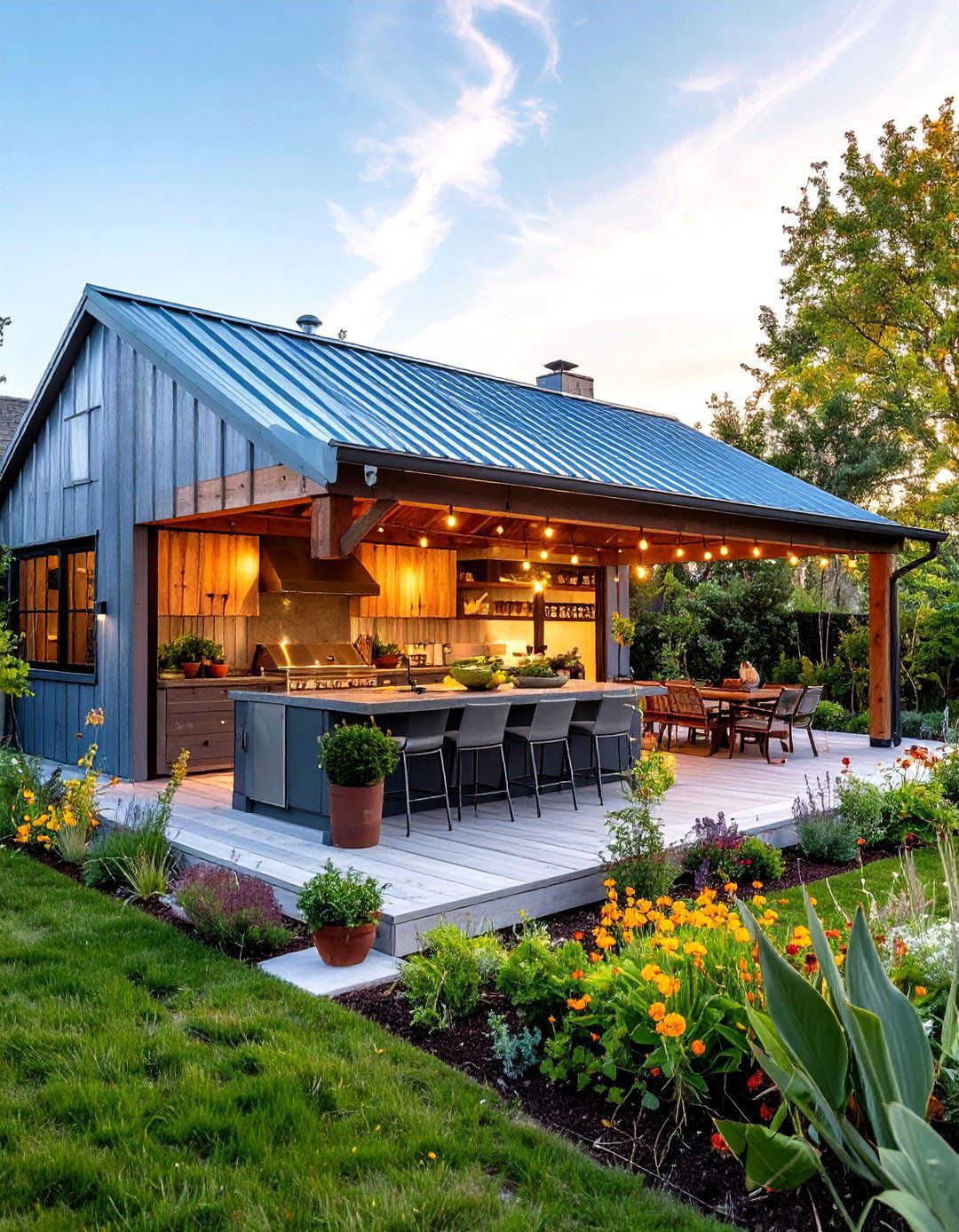

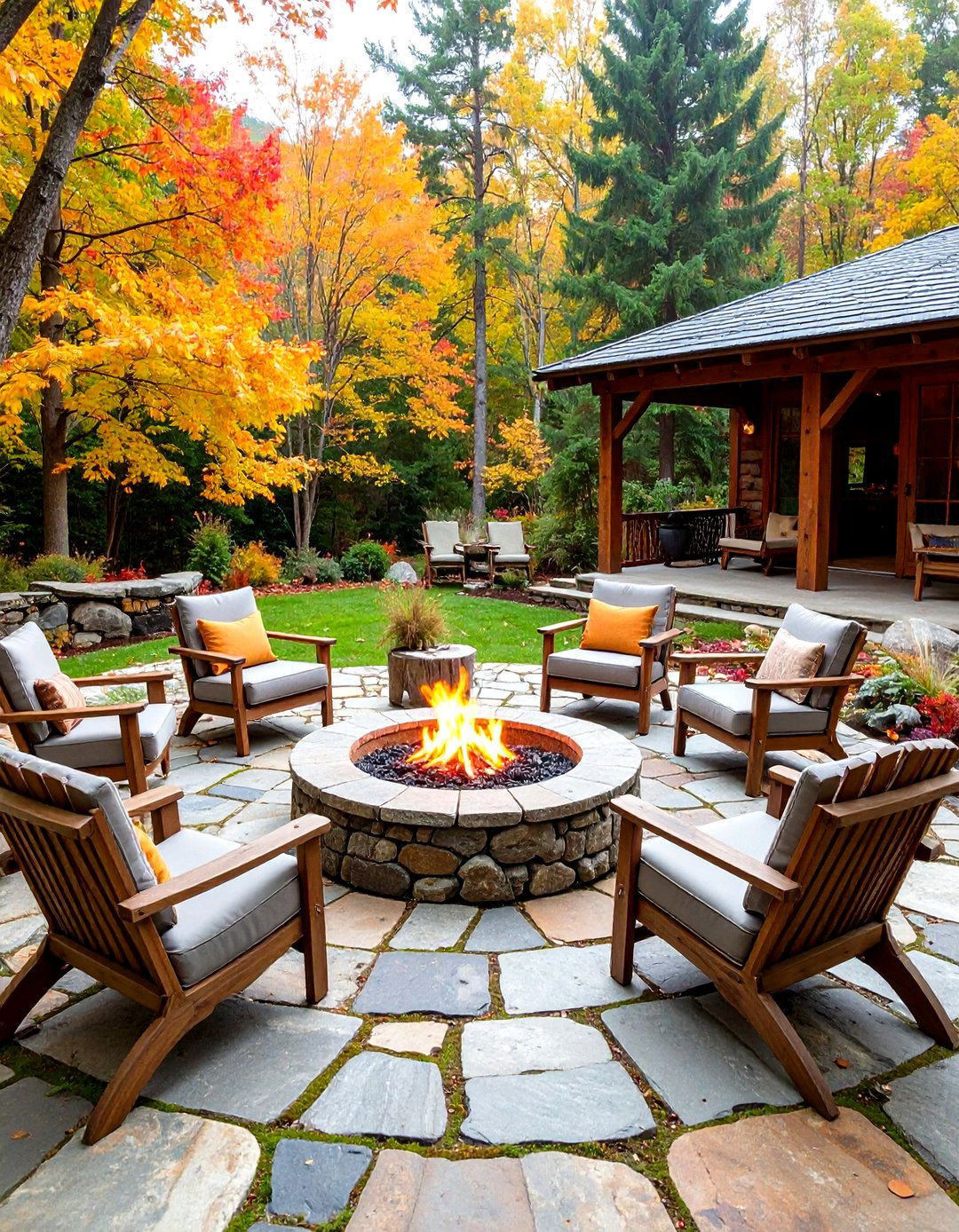
Leave a Reply